

La Casa Nova Costume Supervisor Bible
Larissa Gray
Joint Costume Supervisor: Seren Rees
Head of Wardrobe: Rowan Smith
Student Number: 2102301
This Costume Bible has been edited for the purpose of printing!
Cast List: Pg 3 - 4
Cast Photos: Pg 5 – 7
Contact Sheet: Pg 8 - 14
Tech Schedule: Pg 15 – 19
1st Fitting Schedule: Pg 20 – 21
2nd Fitting Schedule: Pg 22 – 23
Pre-assessment schedule: Pg 24 – 25
Script Breakdown: Pg 26 – 27
Costume Plot: Pg 28 – 30
Rehearsal Notes: Pg 31 – 43
Research: Pg 44 – 62
- Rococo Art: Pg 45 – 46
- Italian Embroidery Styles: Pg 47
- 18th Century Embroidery Techniques: Pg 48 – 49
- Italian Lace: Pg 50
- Nobility Buttons Inspiration: Pg 51
- Working Class Button Inspiration: Pg 52
- Trim Research: Pg 53
- 18th C Italian Embellishments: Pg 54
- 18th C Accessories: Pg 55
- 18th C Women’s Undergarments: Pg 56 – 57
- 1770’s – 1780’s Women’s Dress: Pg 58
- 1770’s Men’s Undergarments: Pg 59
- 1770’s Men’s Fashion: Pg 60 – 61
- 18th Century Shoes: Pg 62
Primary Research: Pg 63 – 67
- AUB Archive: Pg 64 – 65
- Watching La Casa Nova: Pg 66
- Bath Fashion Museum: Pg 67
Avery Kirin: Pg 68 - 100
- Measurements: 69 – 70
- Costume design: Pg 71 – 72
- 1st Fitting: Pg 73 – 76
- 2nd Fitting: Pg 77 – 82
- Pre-Assessment: Pg 83 – 86
- Final photos: Pg 87 – 88
- Costume breakdown: Pg 89 - 92
- Make Breakdown: Pg 93 – 100
Megan Barnwell: Pg 101 – 136
- Measurements: Pg 102 - 103
- Costume design: Pg 104 – 105
- 1st Fitting: Pg 106 - 110
- 2nd Fitting: Pg 111 - 115
- Pre-Assessment: Pg 116 - 118
- Final photos: Pg 119 - 120
- Costume breakdown: Pg 121 - 126
- Make Breakdown: Pg 127 - 136
Brooke Monèt: Pg 137 - 170
Measurements: Pg 138 - 139
-
- Costume design: Pg 140 - 141
- 1st Fitting: Pg 142 - 146
- 2nd Fitting: Pg 147 - 150
- Pre-Assessment: Pg 151 - 153
- Final photos: Pg 154 - 155
- Costume breakdown: Pg 156 - 160
- Make Breakdown: Pg 161 - 170
Maja Lönnroth: Pg 171– 206
Measurements: Pg 172 - 173
-
- Costume design: Pg 174 - 175
- 1st Fitting: Pg 176 - 179
- 2nd Fitting: Pg 180 - 184
- Pre-Assessment: Pg 185 - 187
- Final photos: Pg 188 - 189
- Costume breakdown: Pg 190 - 194
- Make Breakdown: Pg 195 – 206
Jamie McLaughlin: Pg 207 - 242
Measurements: Pg 208 - 209
-
- Costume design: Pg 210 - 211
- 1st Fitting: Pg 212 - 215
- 2nd Fitting: Pg 216 - 220
- Pre-Assessment: Pg 221 - 224
- Final photos: Pg 225 - 226
- Costume breakdown: Pg 227 - 230
- Make Breakdown: Pg 231 – 242
Robert Elson: Pg 243 – 279
- Measurements: Pg 244 - 245
- Costume design: Pg 246 - 247
- 1st Fitting: Pg 248 – 251
- 2nd Fitting: Pg 252 - 256
- Pre-Assessment: Pg 257 - 260
- Final photos: Pg 261- 262
- Costume breakdown: Pg 263 - 267
- Make Breakdown: Pg 268 - 279
Jake O’Mahoney: Pg 280 - 310
- Measurements: Pg 81 - 282
- Costume design: Pg 283 - 284
- 1st Fitting: Pg 285 - 288
- 2nd Fitting: Pg 289 - 294
- Pre-Assessment: Pg 295 - 298
- Final photos: Pg 299 - 300
- Costume breakdown: Pg 301 - 305
- Make Breakdown: Pg 306 – 310
Estimated Budget (makes): Pg 311 – 314
Estimated Budget (sourced): Pg 315 – 316
Final Budget (makes): Pg 317 – 322
Final Budget (sourced): Pg 323 – 324
Hire forms: Pg 325 – 327
Sustainability assessment form: Pg 328 – 329
Cheat Sheet: Pg 330 – 331
Supplier list: Pg 332 – 335
Bibliography: Pg 336 – 341
List of figures: Pg 342– 350
Appendix: Pg 351 - 352

Cast List
Cast List
Anzoletto………………………………………………………… ..Adam Martin
Onifrio/Prosdocimo………………………………………………..Avery Kirin
Cecilia……………………………………………………………. Megan Barnwell
Domenica………………………………………………………….Brooke Monèt
Checca Maja Lonnroth
Rosina……………………………………………………………..Lucy Jayne
Lorenzino………………………………………………………….Fin Whitfield
Cristofolo…………………………………………………………Solo Candy
Count Ottavio…………………………………………………….Jamie McLaughlin
Fabrizio…………………………………………………………….Robert Elson
Lucietta…………………………………………………….Lucy Rose Hutchinson
Oswaldo…………………………………………………………...Jake O’Mahoney
Luaro/Toni……………………………………………………… …Teddy Sterry

Cast Photos












Adam Martin He/ Him
A very Kirin They/ She
Brooke Monèt She/ Her
Finlay Whitfield He/ Him
Jake
O’Mahoney He/ Him
Jamie McLaughlin He/ Him














Lucy Jayne She/ Her
Lucy Rose Hutchinson She/ Her
Maja Lönnroth She/ Her
Megan Barnwell She/ Her
Robert Elson He/ Him
Solo Candy He/ Him
Teddy Sterry He/ Him

Tech Schedule









1st Fitting Schedule


Created by Seren Rees

2nd Fitting Schedule


Pre-assessment schedule

Created by Rowan Smith and Nicole McCafferty

Script Breakdown


Costume Plot





Rehearsal Notes
















Research
Rococo Art
Rococo Art was used in decorative artwork, furniture, paintings, interior design, architecture, and sculptures. This style of design originated in the 18th century in Paris but was then adapted through other countries. Many would describe rococo as elegant as it was carved beautifully into natural forms.
The word Rococo came from the French work Rocaille, which meant shell covered rock work, which was used to decorate grottoes. This style of art was created due to a negative reaction to the baroque style of art that was used in the Palace of Versailles, chosen by Louis XIV. Artists made a lighter style of decoration for the noblemen in France.
This art was made out from delicate curves that interlaced and shapes that were based on the shapes of the letter’s ‘C’ and ‘S’ along with shells and natural forms. When Rococo was used the predominant colours that were used were gold, ivory white and light pastels.
In Italy, Rococo was primarily found in Venice. It was mostly in paintings by Giovanni Battista Tiepolo.

Fig 1. An image of Rococo influenced interior design.
Rococo paintings were characterized by their intricate details which once all put together created the busy appearance that was very popular to the aristocracy. Along with Rococo, mythological scenes, themes of love and portraits made up the bulk of the artwork in this century. They were particularly influenced by the use of colour, erotic subjects and arcadian landscapes.
Rococo could be seen to be one of the most rebellious styles of art in the 18th century, often known as the final expression for the Baroque art style. It was a style of art that didn’t follow any rules.
Rococo artwork was described as illogical and superficial.



Fig 2. A drawing of Rococo styled furniture
Fig 3. Image of a Rococo styled painting
Fig 4. Image of A Rococo influenced sculpture.
Italian Embroidery Styles
There are many different styles of embroidery used in the 18th century. To name a few there was Hardanger, Ricamo antico, rococo, Reticella, Ricamo Classico and Ricamo Bandera.
Punto Antica, an antique stitch, is a classic Italian embroidery style. This is a drawn thread technique, the geometric shapes embedded in this is said to have been inspired by the Arab influence throughout Sicily.
This technique is usually sewn onto even weave fabrics. Punto Antica is used to embellish many things, mainly wall hangings, lamps, ornaments, and bags.


Italian embroidery techniques are known for their attention to detail and precision due to their intricate designs. The styles of embroidery to be considered as the most popular are Punto Antica and Reticella, which are characterized by the main use of metric shapes. Each design is said to have its own narrative alongside it following the cultural heritage and personal experiences of the person who created that specific piece of embroidery.
Throughout history, in Italy, embroidery was also used to preserve tradition and pass down family legacies. A mother in Italy would take it upon herself to teach her daughter how to embroider, teaching her patterns and techniques that have been passed down for generations as it was seen as a way to keep a connection with their ancestors.
Fig. 6 An image of an example of Punto Antica embroidery
Fig. 5 An image of an example of Reticella embroidery
18th Century Embroidery Techniques
During the 18th century embroidery was a professional job, mainly for men. Women also would embroider but for them it was more of s leisure activity due to it dominating clothes.
Court clothing in the 18th century was in high demand of extravagant garments and were willing to pay a lot. Metal thread embroidery and spangles were a popular technique as they caught the light in a ball or banquet. This was created in workshops rather than by hand as it involved stretching fabrics over different sized frames
Metal thread was used for techniques of embroidery such as flat couching, as it was put on the top of the fabric to reduce the amount of waste as the thread was very expensive. This type of thread was flexible which allowed men and women to embroider different complicated shapes well.

Fig. 7 An image of a man’s coat from 1770’s.
Fig. 8 An illustration of what the full jacket would look like.

Spangles, known as sequins, today, were always applied to the surface of the clothing, often paired with metal thread embroidery. Spangles were available in gold or silver, or colours such as pink, green, or blue. They were purposely meant to catch the light.
They were made by taking a metal plate of foil, when they were on top of a lead topped table, they were punched out using a stamp. The size varied, and the shapes were either star, rosettes, or leaves, along with the standard circle. The second method of making spangles was using a coiled piece of wire around a wooden rod, they would be cut into rings which was then hammered into the metal sheet to create the individual spangles.
They were attached by two or three stitches and dotted randomly over fabric.
Fig 7 shows a part of a man’s coat from 1770’s. The embroidery has many different sizes of spangles, pieces of foil and glass pastes. The leaves are made from cream satin and green silk. Bits of purl have also been used.
18th Century Embroidery Techniques
Silk embroidery

Quilting
Quilting was used for warmth, as the wadding would help add the thickness to the clothing. This was an important for the 18th century. Garments that were quilted into were stomachers, bodices, pockets, men’s waistcoat, and jackets, also women’s petticoats. The decorative styles of quilting were flat, stuffed, and corded techniques. The decorative styles were associated with the wealthier members of society. Petticoats that were wadded were made from the good quality satins, and linen padded petticoats were worn in the summer as it was a lighter fabric.
On the frame where the quilting is created, the fabric is not stretched as tight as other techniques The threads that were used were either satin or linen, depending on what fabric is being quilted.
In the 1770’s this type of embroidery was demanding form of needle work The fabric had to be stretched so that there was an even tension. This style of embroidery involved naturalism and was most likely the most popular form of embroidery. The patterns were created using long and short stitches to form different shades, blending multiple colours together. However, the shades of each colours were put together if they worked so there wasn’t a sudden change in shade. All of the colours that were used were what people would find in nature.

Fig. 9 An illustration of what a part of silk embroidery would look like.
Italian Lace
• Lace in Italy is divided into the two categories of needle lace, which is made by hand and then bobbin lace, which is made using machine. Both of these styles were produced in Italy during the Renaissance.
• In Venice, lace became a popular past time for noblewomen and in 1500 lace made a lot of profit. The lace was being made by the young women that were employed in the houses of the noblewomen.
• The pieces of Venetian lace created that were the largest and most intricate were turned into collars and ruffs for the aristocrats and members of nobility.
• A well-known style of lace is called Burano lace, as there was a lace making industry founded in the island of Burano, with an aim to promote lace to the women of Venice.
• In the 18th century lace was very delicate and was usually made from fine linen threads.

11 An image of handmade Burano Lace
Fig. 12 An image of Antique Venetian Rose point lace
A few types of 18th century Italian lace were: Venetian lace, Milanese lace, lace.
• For centuries lace was used as a symbol for finery,
• There were many legends of the origin story of Burano lace Burano that a splash that came from a mermaids tail lace to this day.

• Lace was the most expensive part of a women’s dress, lace was put on men and women’s cuffs, collars, on women’s sleeves, shoulders, and heads.
• The huge demand of lace caused the restriction of lace being imported from other European countries.
Fig.

Nobility Button Inspiration



This style of button will be for the characters of Fabrizio and Count Ottavio. The final button will be gold as it blends well with the colour scheme of their costumes.
The styles for Count Ottavio would most likely look older and slightly ore fancy due to him being one of the older characters, with his fashion looking more outdated in comparison to the other men.
Fabrizio is still a wealthy character in la Casa nova, so his buttons need to reflect his wealth. His buttons might be slightly brighter, but still need to have some detail on them as his costume is lavish and over the top.



Fig. 14 Elaborate Gold shank button from Jones Buttons
Fig. 13 Rope effect antique Gold button from Jones Buttons
Fig. 15 Old Gold shank button from Jones Buttons
Fig. 16 Ornate old Gold
Fig. 19 Gold textured buttons from oh Sew Crafty
Fig. 18 Ornate Gold metal shank button from Totally Buttons
Fig. 17 Gold shank buttons from Etsy
Working Class Button Inspiration



This style of button will be for the characters of Oswaldo and Prosdocimo. They are the working-class servants for the wealthy in the show, and the silver buttons pair best with their costumes.


Prosdocimo and Lauro are the head tradesman and servant, therefore their costumes aren’t very over the top so their buttons need to reflect that.
Which is why I have looked to the older looking silver to look like they don’t have too much money.


Fig. 22 Ornate old silver shank button from Jones buttons
Fig. 21 Plain silver shank button from Jones Buttons
Fig. 23 Celtic knot silver button from Jones Buttons
Fig. 20 swirls and flower silver shank button from Jones Buttons
Fig. 24 Dots antique silver Button from Jones Buttons
Fig. 25 Fancy weave silver shank button from Jones buttons
Fig. 26 Celtic knot silver button from Jones Buttons
Jacket Trim




• Simple
• Intricate
• Adds to the costume but doesn’t overpower?
• Works along the front edge of jackets
• Fabrizio?

• Bolder
• Intricate
• Makes a statement
• Count Ottavio?
• Thicker Braid
Fig. 27 Gold Braid from Barnett and Lawson
Fig. 28 Gold braid from Barnett and Lawson
Fig. 29 Gold Braid from Barnett and Lawson
Fig. 30 Gold Trim from Etsy
Fig. 31 Gold Trim from Etsy

Century Italian Embellishments
Fly Fringe
Fly fringe is a historical trim that is made from silk filament threads, that was very popular for 18th century gowns. The silk filaments were tied in knots and the ends created a spikey arrangement, they were then sewn onto garments or woven into trims to add details and accuracy to gowns. The colours for the fly fringe varied.

Passementerie
This type of embellishment uses a mixture of textile trimmings, this includes braids, buttons, fringing and other textile decorations. The word Passementerie came from the French word ‘passement’ which means a gold/silver braid along with ‘parchmentry’ which was trims that included parchment wrapped in silk. This was a popular embellishment used on 18th century clothing.
This technique was used to add detail and make a bold statement on clothes in the 18th century. This also added more luxury to both men and women’s clothing.

Fig 32 An example of Fly fringe used on 28th century clothing.
Fig. 34 An example of the technique passementerie
Fig. 33 An image of fly fringe pieces
18th Century Accessories

Fans
They started off by being an essential accessory for the wealthy, but it was slowly adapted by all working classes as well. They were decorated with miniature portraits, watercolours and oil paintings. In Italy, the paintings were often classical and taken from famous Roman paintings. They were made from very thin chicken skin, and they were very popular as gifts.
Parasols
Parasols were seen as a symbol of status and authority. They would mostly be made with a long straight handle, which was carved from whalebone. Parasols were made from silk and decorated with lace and ruffles, but overall, they looked quite plain.
Parasols were used to keep the sun off their skin, as tanning was not popular. They were not made to protect women from rain. This accessory was allowed to be used by any member of society, but the working class were not allowed to have one made from fabric. Instead, their parasols would have been created using paper, a cheaper material.

Walking sticks became an essential accessory for men in the 1700’s. There were certain rules that a man would have to follow when out in society, if they failed to do so they would have been shunned from society. These rules were:
• No carrying the walking stick under their arm
• No hanging the walking stick on a button
• No waving the walking stick in the air
To have the ability to carry one, a man would need to have his own license. If they broke any of those rules, they would have had their license revoked.

Fig 35 A painting of a woman holding a parasol.
18th Century Women’s Undergarments
Pocket Hoops/ Panniers
Pocket hoops were another way to create the desired shape for a woman. Pocket hoops were very fashionable but they were not the most practical. The benefits of wearing a pocket hoop were that they were fastened at the front so it made it easier to slip them on and off quickly. They were also collapsable, so women were able to get through tight passageways. They also only sat on the hips, so that this reduced the weight of their clothing.
The difference between a pocket hoop and a pannier is that pocket hoops were lighter and smaller than a pannier. Panniers were bigger and was like a wired skirt that wrapped around the front and back and was very structured. Panniers were worn for more formal occasions, such as balls or fancy dinners.
Petticoat
A petticoat was the next layer after the pocket hoops. The petticoat is another word for a skirt or a slip as a skirt was the term for the lower half of a man’s waistcoat in the 18th century. This garment was usually made from either cotton or linen, which was beneficial in the summer due to the lightweight fabric. Quilted petticoats were sometimes worn for the winter. The purpose of a petticoat was to keep fabric away from a woman’s ankles, allowing them to walk easier without a risk of tripping.
Stays
Stays were worn in the 18th century to support a woman’s bust, but to also shape their bodies, giving their waist a shape of a ‘V’, creating a posture that kept their backs straight and shoulders back. All members of society would wear stays but there were differences between each class. Women of high society would have ones that laced up at the back as they would have had their servants lace them in. Occasionally, the wealthier merchants would have ones that laced at the back also but mostly lower-class women would have stays that laced from the front. In 1770, women wore strapless stays but then as the decade progressed straps became very popular. They weren’t decorated due to the garment not being on show.
Bum Roll
A bum roll was the last item to be worn on top of women’s undergarments. This allowed extra cushioning and support under the petticoat and it would give a desired shape to the women’s dresses. A popular silhouette in the 18th century was to have full hips, the bum pad gave that shape as the bum pad wrapped around onto the waist.
Stockings
Stockings were made from linen, wool or cotton. They would have been in either white, cream, grey, blue, brown or black. The length of women’s stockings would always sit above the knee.




Fig 38 An example of a Pannier
Fig 39 An example of a Pocket Hoop
Fig 40 An example of an 18th century stays
Fig 41 An example of an 18th century bum roll
1770’s – 1780’s Century Women’s Dresses

This dress, and the sack back, was mostly worn as formal wear during the 18th century. The sack back was more of an informal dress. The gown started off by being sewn into the back of the dress right into the waist and then went further into the dress, but then the by the 1780’s the bodice and skirt were cut to be separate pieces. Large sleeve ruffles from the 1740’s was replaced by ruched cuffs in the late 18th century. The robe a la Francaise had a matching or contrasting petticoat underneath and a stomacher that opened at the front. Another popular dress was Robe a la Polonaise, this was between the 1770’s and 1780’s.
Women would wear a stomacher, which was a triangular panel that was worn on the front of their dresses to cover them up due to the sack back being open at the front. They were mostly decorated with embroidery, jewels, lace and ribbon.


Fig 42 an 18th century women’s Robe a la Francaise
Fig 43 An example of the back of an 18th century women’s Robe a la Francaise
Ruched cuffs
Sack Back
Matching Petticoat
Fig 44 An example an 18th century stomacher
Drawers
1770’s Men’s Undergarments
In the 18th century, drawers were a part of men’s underwear. They were made from linen, which made them easier to wash. The construction of the drawers included very fine stitching as the tiny stitching reduced the risk of the fabric fraying when going through the hand washing process, which was very harsh during this century.
They were the same shape as breeches as they would have been worn over the top of the drawers. Over the knee bands, linen tape was attached as the fastening which held up the men’s stockings. There were buttons on the waistband and eyelets were on the back, this was then tied together with linen tape as well. Having the linen tape on the back allowed room to give in the clothing, as there was no stretchy fabric in the 18th century.
Stockings
Men would wear stockings with their breeches. Important men of society wore stockings that were made from a fabric such as silk, when men of lower status would wear ones made from materials such as wool.

The best type of stockings for the 18th century were those that were made from either wool, linen, or cotton. The colours would be either: white, blue, black, or grey. They would also sit above the knee so that the drawers had enough fabric to keep up securely.

Shirt
Men wore a shirt for underwear with the function of hygiene as the process of daily baths was not a thing. They were worn for modesty, and they were another indication of status. Men would buy multiple shirts so they could wear a clean one each day. They were made from linen as it is a durable fabric that could be washed.
Like the drawers, the hand stitching on the seams was fine to withstand the washing process. Many shirts had fine pleats that were ironed on the sleeves to fit comfortably underneath the sleeves of the jackets that would have been worn over the top of this.
Fig 45 An 18th century men’s shirt and drawers Fig 46
1770’s Men’s Fashion
Men’s clothing in the 18th century saw the involvement of bright colours, detailed embroidery, and expensive lace. Men’s jackets included large cuffs and pleats on the back of the jacket from the waist to the hem. Waistcoats were longer and went past the man’s back.
Habit à la Francaise
This is what the style of outfit was called that nobility would wear. It consisted of a jacket, waistcoat, and breeches. Men would wear silk stockings, a cravat, a jabot, and a linen shirt.
In the 18th century it was clear that embroidery was heavily used on men’s fashion rather than women’s dresses. Habit à la Francaise’s were heavily embroidered, sometimes with gold and silver threads.
Neckties
Cravats were introduced in the 17th century. They were long thin piece of lace or linen, and it would hang down from their necks. By the end of the 18th century, they had increased in popularity but they were made out of silk instead.
However, in the 18th century, jabots overtook the popularity of cravats. They were filly decorative ruffles that would have hung at the front of the shirt. These neckties were made from lace or cambric, and they were sewn on to the front opening of their shirts. Afterwards they were developed to be secured at the neck using a pin or band.
There were alternatives to the cravat, and in the 18th and 19th century the ‘stock’ was introduced. Stocks were fastened at the back with a knot or a hook. They were made from linen and they were a long piece of cloth that wrapped around the neck, it would result in looking like a pre tied bowtie.
Suits


By the 1770’s the style of men’s suits changed to become slimmer than the previous decades. The front of the coats were curved to below the waist and the cuffs of the jackets were enlarged and deep. The sleeves of the jackets became more designed to shape and fit the arm, and the pattern was just to give space and movement to the bend in the elbow. From the 1760’s, waistcoats were sleeveless, this was an important change as many were constructed like a jacket. The skirt of the waistcoats would finish at the man’s hip.
The style of breeches changed from a fly front to a fall front in the 1770’s. They were very visible and the shaping of the breeches were a lot slimmer than previous styles. Fall front breeches had a flap at the front of the pants that falls down which allowed men to go to the bathroom without having to take their breeches down. They would have button fastenings and buckles on the knees.
Men’s jackets were always lined with silk. They were also heavily embroidered with bright colours and floral motifs, nearer the end of the 18th century the embroidery was placed on the front, back, pocket, cuffs and buttons.
Fig 47 18th century men’s jabot




Fig 50 18th century men’s stock
Fig 48 18th century fall front breeches
Fig 51 An example of a man’s 18th century Habit à la Francaise
Fig 49 An example of a man’s 18th century waistcoat
18th Century Shoes
Men and Women’s shoes were a strong symbol for their status in society in the 18th century alongside their fashion choices.
Women’s shoes
Women wore shoes with a high heel and they were made from thin leather or colourful silk. Their shoes weren’t matching with their dresses, it was too expensive to use the same fabric. They were decorated with gold and silver lace, or braid. Most shoes used decorative buckles on the front. Women’s shoes were slightly rounded or pointed. They laced up with silk ribbon or they were fastened with a buckle, therefore the reason why they were called buckle shoes in the 18th century.
Fig 53 An example of an 18th century women’s shoes

Fig 52 An example of an 18th century men’s shoes

Men’s shoes
In the 18th century a man’s ankle was an important attribute to show off. Their shoes were made from dark leather and was fastened with a big shiny buckle, this was a good way to highlight the ankles against the lightcoloured stockings. The buckles for the shoes were made

Fig 54 An example of how 18th century shoe buckles worked.
From steel or brass and sometimes had engravings or was layered with jewels. Sometimes men’s shoes were coloured for certain occasions.
During this century shoes were made with soles that didn’t specifically fit either the left or right foot. This made the shoes very uncomfortable. They were made on straight lasts, which were the soles of the shoes.
Men and women would find themselves switching the shoes over from one foot to another to reduce the pain, this made it more difficult to walk smoothly, and they had to learn from a young age of how to walk in them.

Primary Research
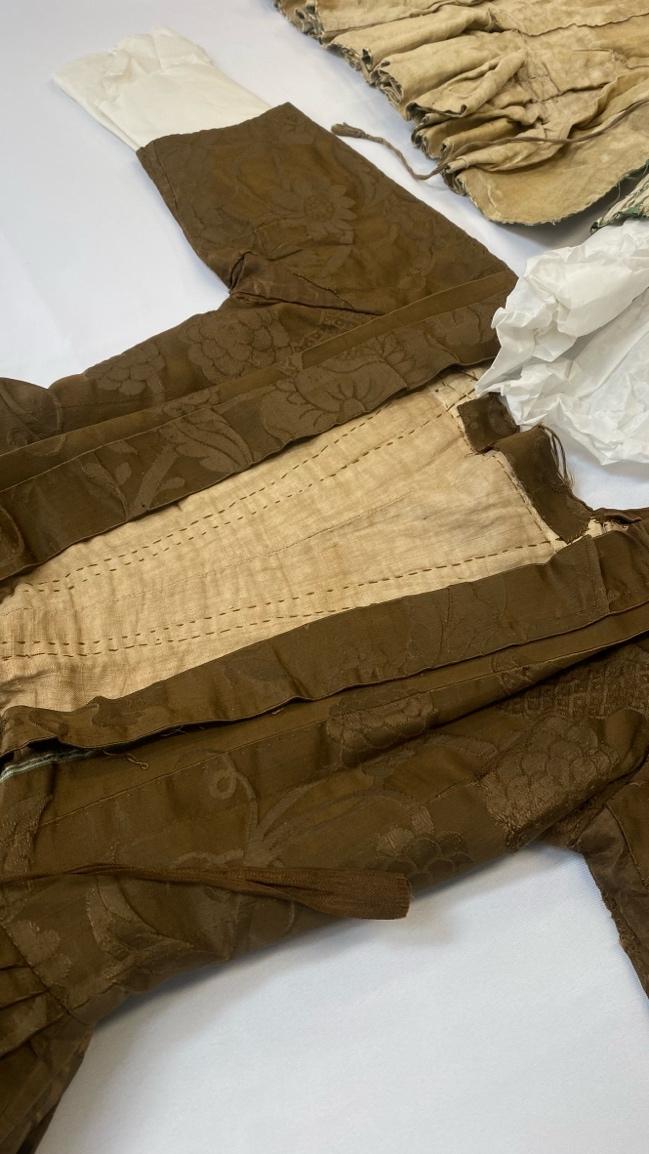
AUB Archive – 18th century clothing
- Fabric is from the 1740’s
- Dress and colour - 1790s roughly
- Prints got smaller and this is bigger print
- Brown clothing so they didn’t need to wash it
- Might have extended to fit over pocket hoops
- Very good condition - not worn often
- Pocket hoops on both sides
- Worn with a stomacher and petticoat
- More like a polonaise
- English robe l’anglaise - pleating is






AUB Archive 18

neck
- Upper day wear
- French dress



Watching La Casa Nova




I watched another version of La Casa Nova; I chose to do this so I could see how the characters are portrayed and how they would need to present themselves on stage through the costumes. It has helped me get to know the characters more through their style of clothing in this play, the only elaborate costumes were Cecelia and Count Ottavio.
However, this play was the only one I could find on the internet and it was in Italian, with no English subtitles. Due to having read the script before I watched this, I knew some parts of what was going on. This allowed me to focus on their clothing instead of what they were saying, which gave me a new perspective for each of the characters.

Fig 51 La Casa Nova, Cecelia
Fig 52 La Casa Nova, Count Ottavio
Fig 53 La Casa Nova, Anzoletto, Cecelia and Cristofolo
Fig 54 La Casa Nova, Cristofolo and Checca



Bath Fashion Museum




Avery Kirin






Photos taken by Jayne Jackson

Costume Design
Prosdocimo

Costume Design by Maya Mansfield


1st Fitting

Before




Photos taken by Rachel Lacey


After



Photos taken by Rachel Lacey
Fitting Notes
Character: Prosdocimo
Actor: Avery Kirin
Maker: Heidi Jorgensen
Garment Notes
Breeches
• Adjust inside leg at knee as pinned.
• Adjust length as marked.
• Adjust Centre front fall as pinned to extend Centre front and adjust for a sway waist. Shirt
• Reduce cuffs by 1” on sleeve.
• Adjust gathers on the back, add a couple of inches for fullness.
Waistcoat
Notes taken by Nicole McCafferty
• Adjust armholes as marked.
• Adjust shoulder as pinned.
• Adjust centre back as pinned.
• Shorten dart to safety pin.
• snip side under arm.

2nd Fitting


Before



Photos taken by Rosie Maddox


Before



Photos taken by Rosie Maddox


Before



Photos taken by Rosie Maddox


After



Photos taken by Rosie Maddox
2nd Fitting Notes
Character: Prosdocimo
Actor: Avery Kirin
Maker: Heidi Jorgensen
Garment Notes
Breeches
Jacket
• Buttons on front of breeches
• Let knees out 1 inch.
• Take off overlap.
• Let out armhole (too tight)
• Let out sleeves on seams.
• Big buttons – Maybe Fabrizio’s?
• Re-position pocket flap as pinned.
Extra Notes
Notes taken by Nicole McCafferty
• Add pleat to sleeve (or gathering)
• Buckle on left shoe is broken.


Pre-Assessment




Photos taken by R owan Smith




Photos taken by
R owan Smith
Pre-Assessment Notes
Character: Prosdocimo
Actor: Avery Kirin
Maker: Heidi Jorgensen
Garment Notes
Waistcoat
Jacket
Shirt
Extra Notes
Notes taken by Rosie Maddox
• Buttons – 8 flowers along waistcoat
• Lengthen Jacket cuff by inch.
• Pleat in shirt cuff to shorten.
• Look again for hat.
• Needs a red mask.
• No cape
• Could add leather strap and buckle to shoes.


Final Photos




Costume Breakdown

Item Buy, Hire, Make?
Supplier
Make N/A N/A
Make N/A N/A


Make N/A N/A

Shirt
Breeches
Waistcoat
Jacket Make N/A N/A

Make N/A N/A
Hire AUB Costume Store N/A


Cravat
Braces
All photos above were taken by Heidi Jorgensen




Make Breakdown
Production La Casa Nova (Period)
Designer Maya Mansfield
Supervisor Larissa Gray
Maker Heidi Jorgensen
Actor Avery Kirin
Character Prosdocimo
Costume Item Fabric/material


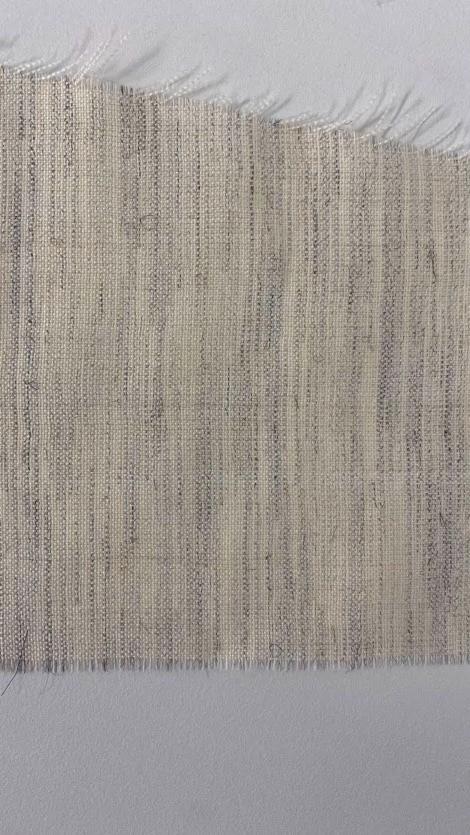
Linen Tape VV Rouleaux
£1.25 5m
Wadding AUB Haberdashery
£5.90

cotton AUB Haberdashery
£5.90

Stay flex AUB Haberdashery
£4.70 1.3m


Cotton
Black
Black Thread AUB Haberdashery
£2.00
Covered Buttons 20mm AUB Haberdashery
£0.15
Waistcoat Brown wavy fabric AUB
£10.00
Waistcoat Lining/Baking AUB Haberdashery
£4.60




cotton Empee Silks
£2.25
AUB
£0

Canvas AUB Haberdashery
£6.50
Black eyelets AUB Haberdashery
£0.04


Black
Buttons
Hair
Linen Tape






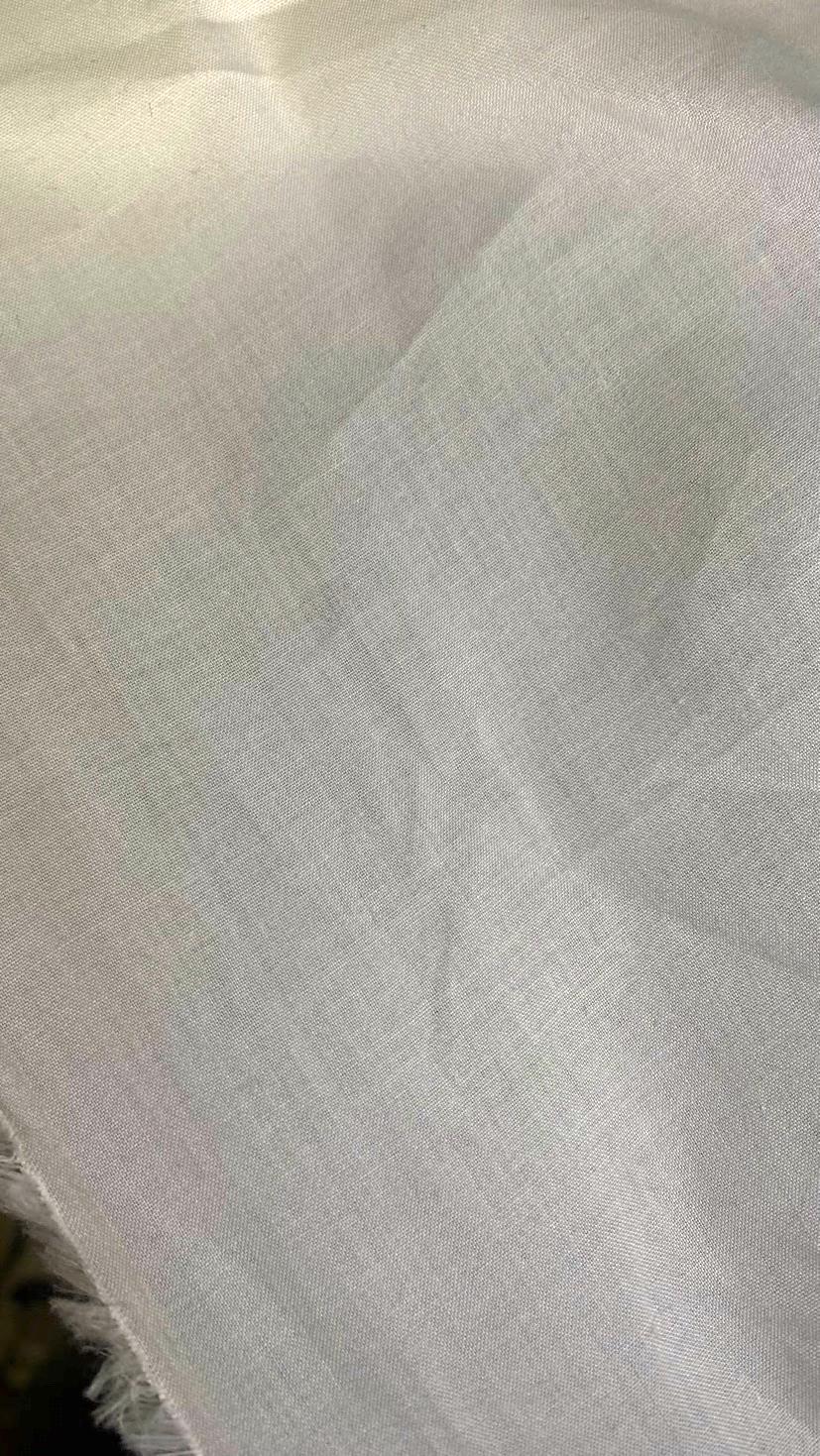

Shirt Cotton Lawn Empee Silks
£1.75
White Thread Amazon
£1.29


Cravat Cotton Lawn Empee Silks
£1.75


Megan Barnwell






Photos taken by Jayne Jackson

Costume Design
Cecilia

Costume Design by Maya Mansfield


1st Fitting


Before



Photos taken by Rachel Lacey

Before




Photos taken by Rachel Lacey


After



Photos taken by Rachel Lacey
Fitting Notes
Character: Cecilia
Actor: Megan Barnwell
Maker: Jasmine Bevan
Garment Notes
Top Skirt
• Top skirt re-pleated to match stomacher.
• Waistline 1cm from raw edge on top skirt
Bodice
Extra Notes
Notes taken by Nicole McCafferty
• Change sleeve as pinned.
• More width at the top for volume on sleeve
• Samples for different methods and sizes of ruffles
• Gold braid
• Pleats do not gather on sleeve lace.
• Adjust neckline at next fittings.
• Consider fastenings for paneers.
• Underskirt 1” off floor


2nd Fitting


Before


Photos taken by Sophie Ca n niffe

Before


After


Photos taken by Sophie Canniffe


After
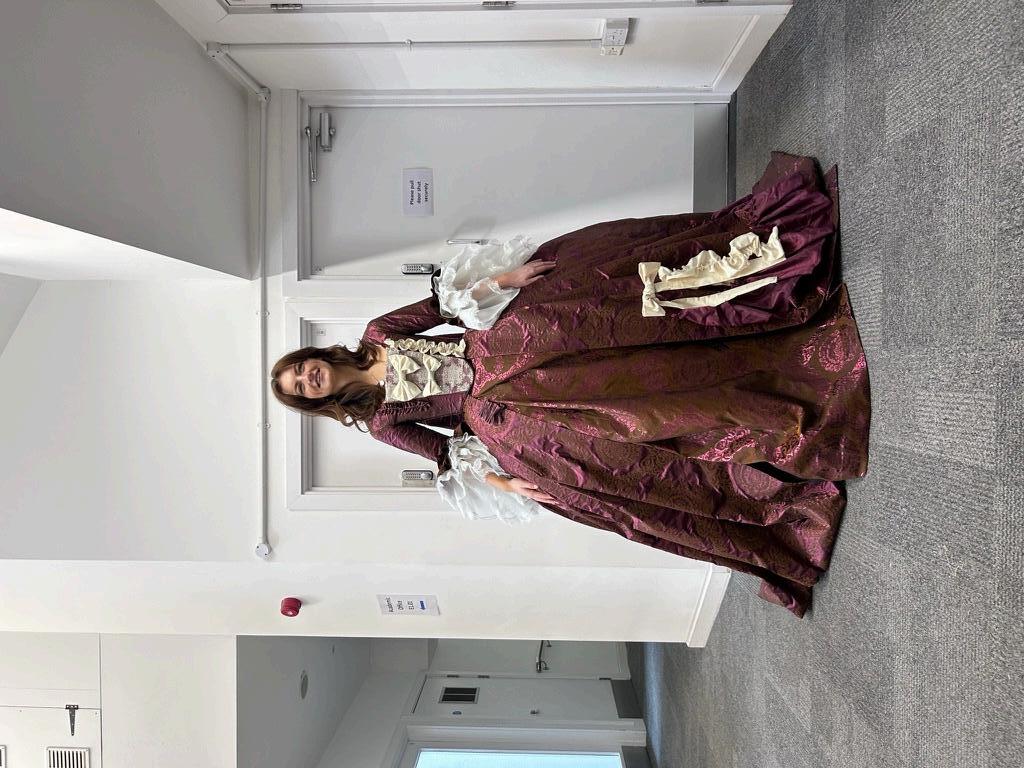

Photos taken by Sophie Canniffe
2nd Fitting Notes
Character: Cecilia
Actor: Megan Barnwell
Maker: Jasmine Bevan
Garment Notes
Bodice
Extra Notes
Notes taken by Nicole McCafferty
• Pleats facing the same way – back of the sleeve closer to the point of the back armhole.
• Take out lace and shorten the cuff.
• Armhole to be made bigger at the bottom.
• Bows in fabric from the stomacher
• Change the bows to be floppier.
• Bow in the headdress to be black instead of white.
• In sole in show and maybe heel grip
• Larger bum roll


Pre-Assessment




Photos taken by R owan Smith
Pre-Assessment Notes
Character: Cecilia
Actor: Megan Barnwell
Maker: Jasmine Bevan
Garment Notes
Petticoat
Skirt
Bodice
Extra Notes
Notes taken by Rosie Maddox
• Hem petticoat up by 4 inches – add a machine pleat
• Hem to pinned length.
• Black frill at bottom is eye catching, remove it and leave plain but might end up adding the yellowish taffeta style fabric.
• Sides of hem down on overskirt by couple of inches
• Add more structure for bows/ sew to stop flopping.
• Piping tightening on bodice
• Top bow moved up to neckline.
• Sew own to secure sack back at top
• Bum roll is too big for waist.
• Tights
• Insoles in shoes
• Thick pink ring, take off duct tape.
• Pink pearl earrings


Final Photos




Costume Breakdown

Item Hire, Buy, Make?
Make N/A N/A
Underskirt Make N/A N/A

Make N/A N/A


Pannier
Petticoat
Sack Back Make N/A N/A

Headpiece Make
Make


Necklace
Shoes Hire AUB
Costume store N/A
Tights Hire AUB
Costume Store N/A

Hire AUB
Costume Store


Earrings
Ring Hire AUB
Costume Store
Ring Hire AUB
Costume Store
Vest Top Hire AUB
Costume Store





Bum Roll Hire
Cape Hire


Make Breakdown
Production La Casa Nova (Period)
Designer Maya Mansfield
Supervisor Larissa Gray
Maker Jasmine Bevan
Actor Megan Barnwell
Character Cecelia
Costume Item Fabric/material


AUB
£2.00
£2.25 1m Stay flex AUB Haberdashery
£4.70 0.5m
£1.94 6m




Dark Pink thread
Black Cotton Empee Silks
Eyelash lace Etsy
White organza AUB
Haberdashery
£12.45 2m
Black cotton AUB
Haberdashery
£5.40 3m

Stay Flex AUB
Haberdashery
£4.70 0.5m

Black Petersham AUB
Haberdashery
£0.95 1m


Petticoat
Pink Brocade UK Textiles
£25.00 See above
Black thread AUB
£0 1 reel
Underskirt White cotton Empee Silks
£1.75 7m
Black Organza AUB Haberdashery
£10.00 1m

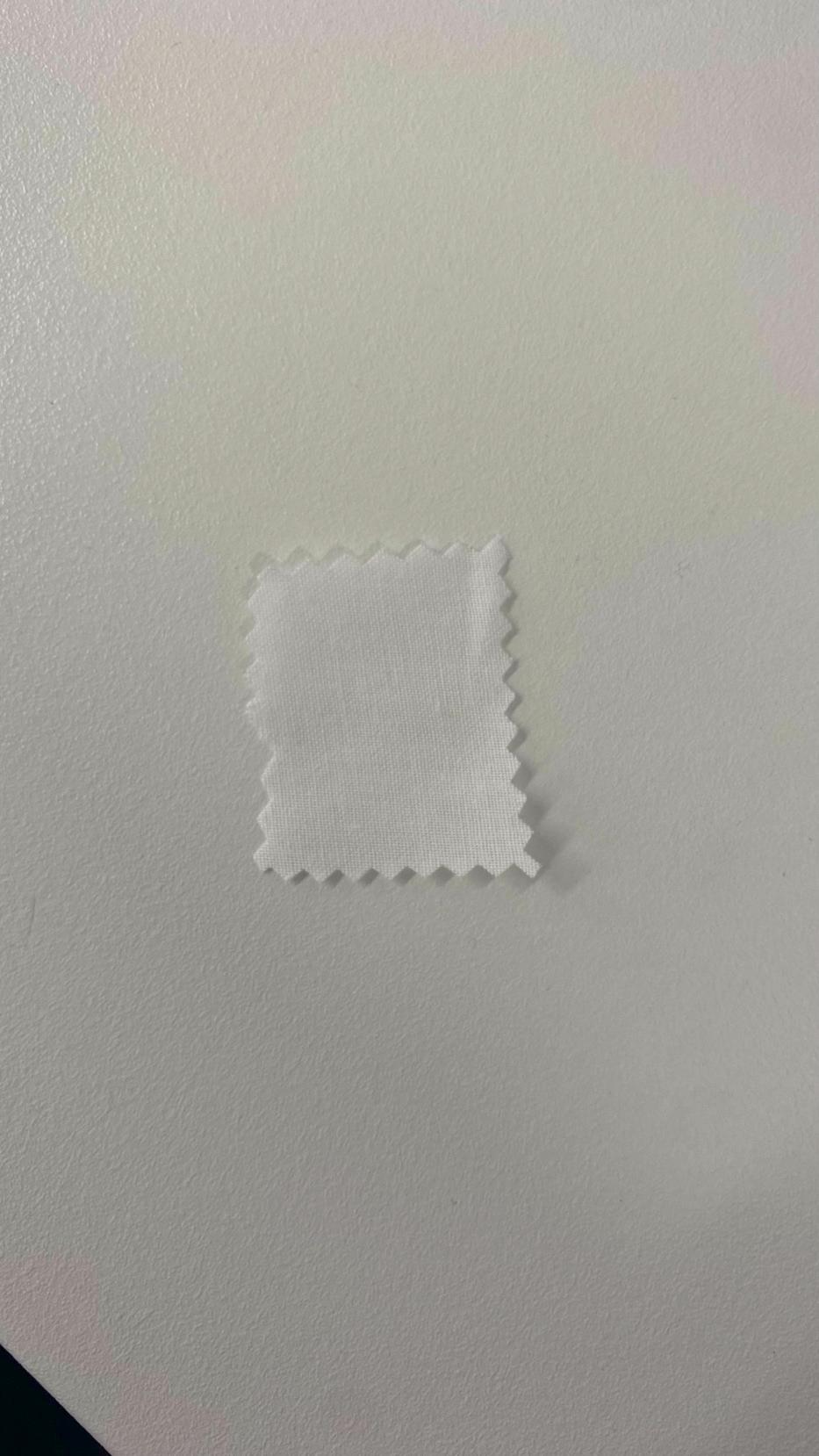


Stay Flex AUB
Haberdashery
£4.70
Pannier Bleached Calico AUB
Haberdashery
£4.00 5m
Crinoline steel 16mm AUB Haberdashery
£7.00



£0.30
Cotton Drill Empee Silks
£0.53
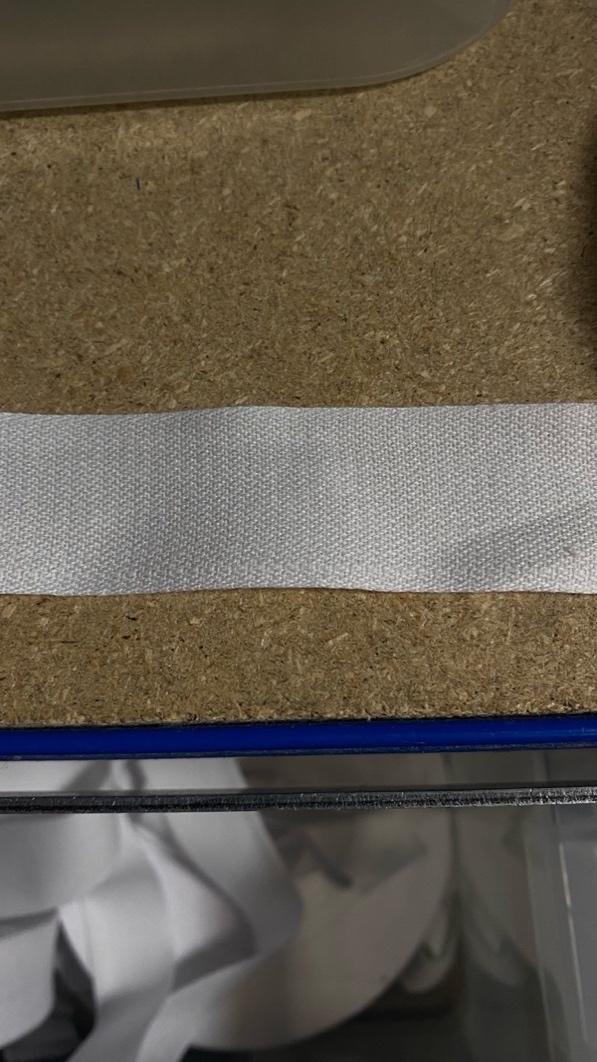




Bodice
Black corset lace AUB
Haberdashery
£2.25
Piping cord AUB
Haberdashery
£0.15 4.07m

£1.25



Red Ribbon VV Rouleaux
Plum Ribbon



Headpiece Scalloped Lace
£3.99
Black Velvet Ribbon Fabric Land
Necklace Prink Brocade Fabric Uk Textiles
£25.00






Brooke Monèt






Photos taken by Jayne Jackson

Costume Design Domenica

Costume Design by Maya Mansfield


1st Fitting


Before



Photos taken by Rachel Lacey

Before




Photos taken by Rachel Lacey




Photos taken by Rachel Lacey
Garment
Bodice
Extra Notes
Fitting Notes
Character: Domenica
Actor: Brooke Monèt
Maker: Rebecca Li
Notes
• Drop shoulders 1”
• Lower bones 1”
• Domette bodice
• Open seam at stomacher as pinned.
• Change shape of sleeves as pinned.
• Flatten underarm of armhole.
• New front neckline on raw edge
• 1cm seam allowance from Centre back to side seam – see pins to match into front design line.
• Underskirt 1” off ground as pinned.
• Petticoat 1” higher than underskirt
• Top skirt as pinned.
• Samples in sheer fabric on end of sleeve
• Look for trim for front stomacher.
• Long tail on the shawl
• Scrap apron.
Notes taken by Nicole McCafferty


2nd Fitting





Photos taken by
R osie Maddox


After



Photos taken by R osie Maddox
Fitting Notes
Character: Domenica
Actor: Brooke Monèt
Maker: Rebecca Li
Garment Notes
Bodice
Extra notes
Notes taken by Nicole McCafferty
• Tighten piping.
• Bow with small tails on front of stomacher.
• Ruffle with frayed edge, round the neckline and down.
• Silk ribbon for flowers
• 3 metres silk organza


Pre-Assessment




Photos taken by
R owan Smith
Pre-Assessment Notes
Character: Domenica
Actor: Brooke Monèt
Maker: Rebecca Li
Garment Notes
Bodice
Skirt
Extra notes
Notes taken by Rosie Maddox
• Flowers and Ribbons to be added.
• Trim placed halfway over white frill of overskirt as pinned.
• Another petticoat
• Jewellery: Pearl necklace, needs pearl earrings


Final Photos




Costume Breakdown

Item Hire, Buy, Make?


N/A

Pocket Hoops Make
Petticoat Make
Underskirt Make



Shawl Make N/A
Head piece Make N/A
Shoes Hire AUB Costume Store N/A
Hire AUB Costume Store N/A

Hire AUB Costume Store N/A


Earrings
Necklace
Ring Hire AUB Costume Store
Tights Hire AUB Costume Store




Make Breakdown
Production La Casa Nova (Period)
Designer Maya Mansfield
Supervisor Larissa Gray
Maker Rebecca Li
Actor Brooke Monèt
Character Domenica
costume




Piping cord AUB
Haberdashery
£0.15
White organza AUB
Haberdashery
£12.45 1m
Cream Lace Etsy


Thread AUB
£0


Thin
Pink




Blue satin ribbon Fabric Land
£0.28 2m
Lilac satin ribbon Fabric Land
£0.69 2m
Pink satin ribbon Fabric Land
£0.28 2m
Mauve Satin ribbon Fabric Land
Green Satin Ribbon
(fittings)
£0.28




Haberdashery
£0.30
White organza AUB Haberdashery
£1.29 1 reel





Petticoat Cotton Tape AUB
White Cotton Empee Silks
White Thread Amazon
Cream silk taffeta UK Textiles
£35.00 See above
Haberdashery
£6.00
Haberdashery
£0.30
£0.49
Haberdashery
£5.40




Pocket Hoop Crinoline steel
Cotton tape
Silver Buckle Fabric Land




Bodice Cotton Drill




White corset lace
Shawl Pink Lace
Headpiece Thin Cream Lace
Plum Ribbon
Ribbon VV Rouleaux
£1.25
£1.25

Closures Hook and bars AUB
Haberdashery
£0.40
Hooks and eyes AUB
Haberdashery
£0.10
Snap fastenings AUB
Haberdashery
£0.50




Yellow
Red Ribbon VV Rouleaux

Maja Lönnroth






Photos taken by Jayne Jackson

Costume Design Checca

Costume Design by Maya Mansfield


1st Fitting


Before Photos were missed during the fitting, this is where they would have been.




After


Photos taken by Rachel Lacey
Fitting Notes
Character: Checca
Actor: Maja Lonnroth
Maker: Elsie Howard
Garment Notes
Petticoat
• Waistband on petticoat needs to be tighter.
• Petticoat lifted on one side (actor’s left) and front at the waistband.
• Level waistband at front on petticoat.
• 5cm from floor
Bodice
Top Skirt
Underskirt
Notes taken by Nicole McCafferty
• Extra eyelet on the bottom
• Take in pleat at centre as pinned.
• Snip into sleeve.
• Bones and eyelets need to be higher.
• More bones on side front panels
• Resize armhole as pinned.
• Take in on side as pinned.
• Bones to the top on the centre back but keep opining the same.
• Sleeve - Two pleats as drawn and pleat in elbow on sleeve.
• Finish top skirt where pinned.
• Take up top skirt as pinned.
• 7cm from floor


2nd Fitting


Before


Photos taken by Sophie Canniffe


Before


Photos taken by Sophie Canniffe


After


Photos taken by Sophie Canniffe
Fitting Notes
Character: Checca
Actor: Maja Lonnroth
Maker: Elsie Howard
Garment Notes
Skirt
• Waistline adjusted on top skirt to lay flat.
• Add piping down to the front edge of the top skirt.
• Press all pleats on the bottom frill.
• Double edged lace over frill?
Bodice
Extra notes
Notes taken by Nicole McCafferty
• Make armholes bigger by 1cm on the bottom.
• Alter the sleeve as pinned at sleeve.
• Take in sleeve cuff.
• Stab stitch at the front of the bodice.
• Tighten piping on neckline.
• Wider tails on bows
• Single layer on shawl
• Size up shoe
• Source fly fringe?
• Flat flowers


Pre-Assessment


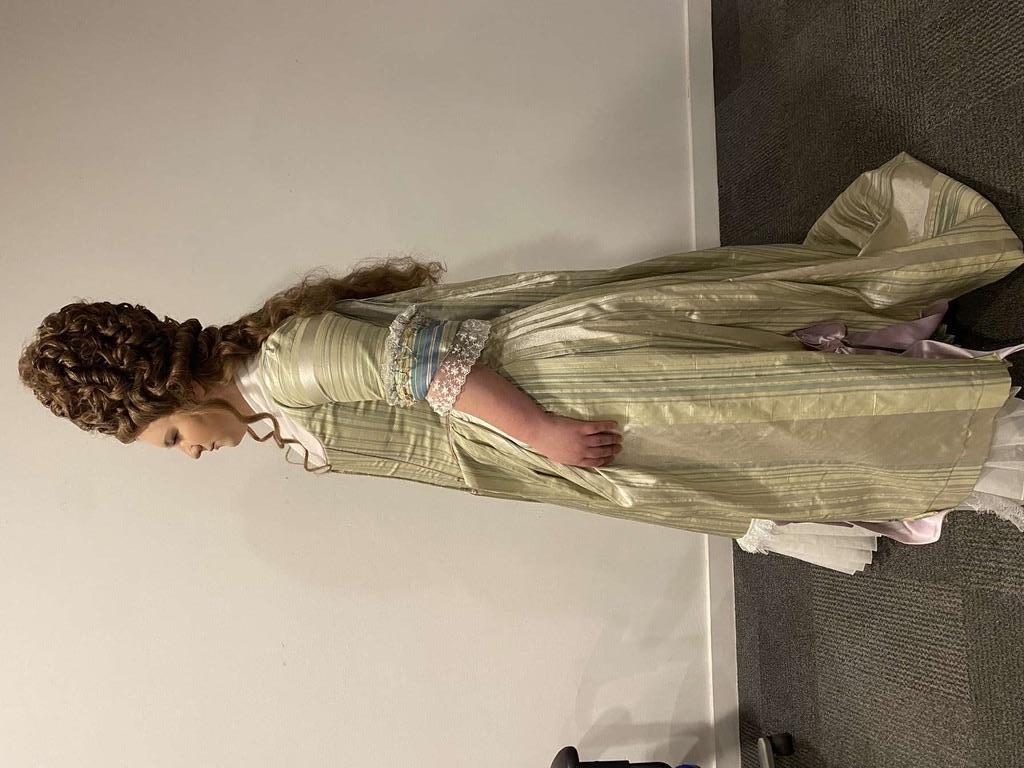

Photos taken by
R owan Smith
Pre-Assessment Notes
Character: Checca
Actor: Maja Lonnroth
Maker: Elsie Howard
Garment Notes
Skirt
Bodice
Headpiece
Extra notes
Notes taken by Rosie Maddox
• Change lace to be more structed, thick lace cut in half.
• Covered buttons on bodice.
• Raw edge cuff needs more fullness so take off lace to do.
• Headpiece bow shorter tails
• Check dressing may need to lift hem at front or at waist.
• Try different shoes, need 6.5/7 but need same height heel for hem.


Final Photos




Costume Breakdown

Item Hire, Buy, Make?



Pocket Hoops Make
Petticoat Make N/A
Underskirt
Sack back Make N/A


Fishu Make N/A
Headpiece Make N/A



Shoes Hire AUB Costume Store N/A
Stockings Buy Ann Summers -
Hire AUB Costume Store N/A

Earrings


Make Breakdown
Production La Casa Nova (Period)
Designer Maya Mansfield
Supervisor Larissa Gray
Maker Elsie Howard
Actor Maja Lonnroth
Character Checca
Part of costume Fabric/material
Sack Back Blue striped fabric UK Textiles



Cotton Drill Empee Silks
£3.25
Etsy
£0.80 5m
Etsy
£1.95 1.27m

fabric (piping) Uk Textiles
£0 0.5m

Empee Silks
£1.75 3m

Lace (Thick lace)
Lace (Thin lace)
Pink
Cotton Backing (white)
Pleated Fabric Ciment Pleating
£16.00 1m
AUB
£10.00
organza AUB Haberdashery
£12.45


Thread AUB Haberdashery
£2.00 1 reel


Pink Silk taffeta
White
Cream
Cotton tape (fittings)
£1.50
£1.75 8m

£0.30 1m

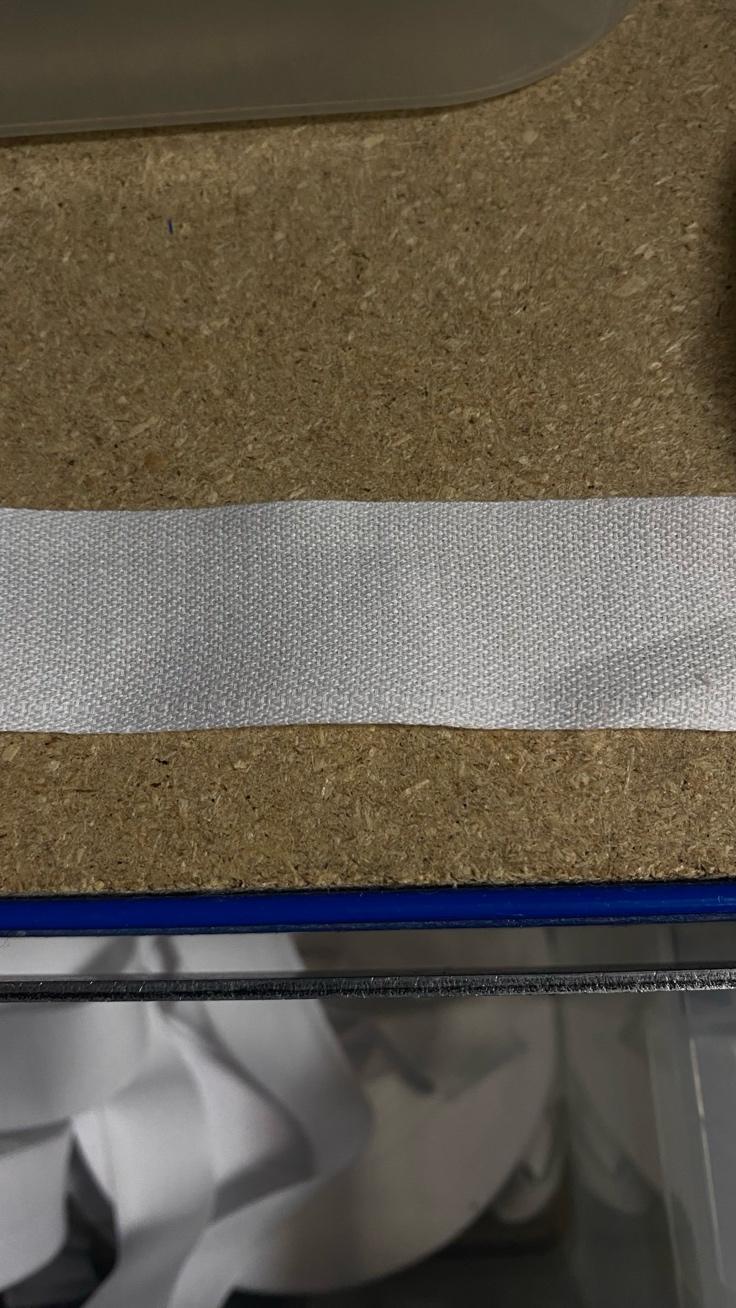
Fishu Muslin
Underskirt Cotton Empee silks







Yellow Ribbon
Petticoat Cotton tape (fittings)
£0.30
Cotton Organdie AUB Haberdashery
£15.00
White Cotton Empee Silks
£1.75
Blue striped fabric
£45.00
£6.00



Pocket
AUB
Haberdashery
£4.70
AUB
Haberdashery
£0.50

£3.25

AUB
Haberdashery
£0.71


Stay flex
Silver buckle
Bodice Cotton Drill Empee Silks
Steel Boning
Spiral bones AUB
Haberdashery
£0.78
Silver eyelets AUB
Haberdashery
£0.04
White corset lace AUB
Haberdashery
£2.25

Piping Cord AUB
Haberdashery
£0.15




Silk Filaments Amazon
£16.29
Covered buttons The Trimming Shop
£2.15
AUB
Haberdashery
£0.19

AUB Haberdashery
£10.00



Bias tape
Headpiece Pink Silk Taffeta
Yellow Ribbon Fabric Land
Closures Hook and bars AUB
Haberdashery
£0.40
Hooks and eyes AUB
Haberdashery
£0.10
Snap fastenings AUB
Haberdashery
£0.50




Jamie McLaughlin






Photos taken by Jayne Jackson

Costume Design Count Ottavio

205
Costume Design by Maya Mansfield


1st Fitting

Before



Photos taken by Rachel Lacey


After


Photos taken by Rachel Lacey
Fitting Notes
Character: Count Ottavio
Actor: Jamie McLaughlin
Maker: Emiliya Kezhina
Garment Notes
Breeches
• 4” on front panel
• Move split forward.
• Move side seam.
• Pleats need to go opposite direction and new start point.
• Let out knee 1”
Shirt
Jacket
Notes taken by Nicole McCafferty
• Let out neck 2cm.
• Let out 2cm at centre back.
• Let sleeve out as pinned.
• Take in back side seams as pinned.
• Take up jacket hem as pinned.
• Pocket as drawn.
• Jacket neckline as drawn.


2nd Fitting
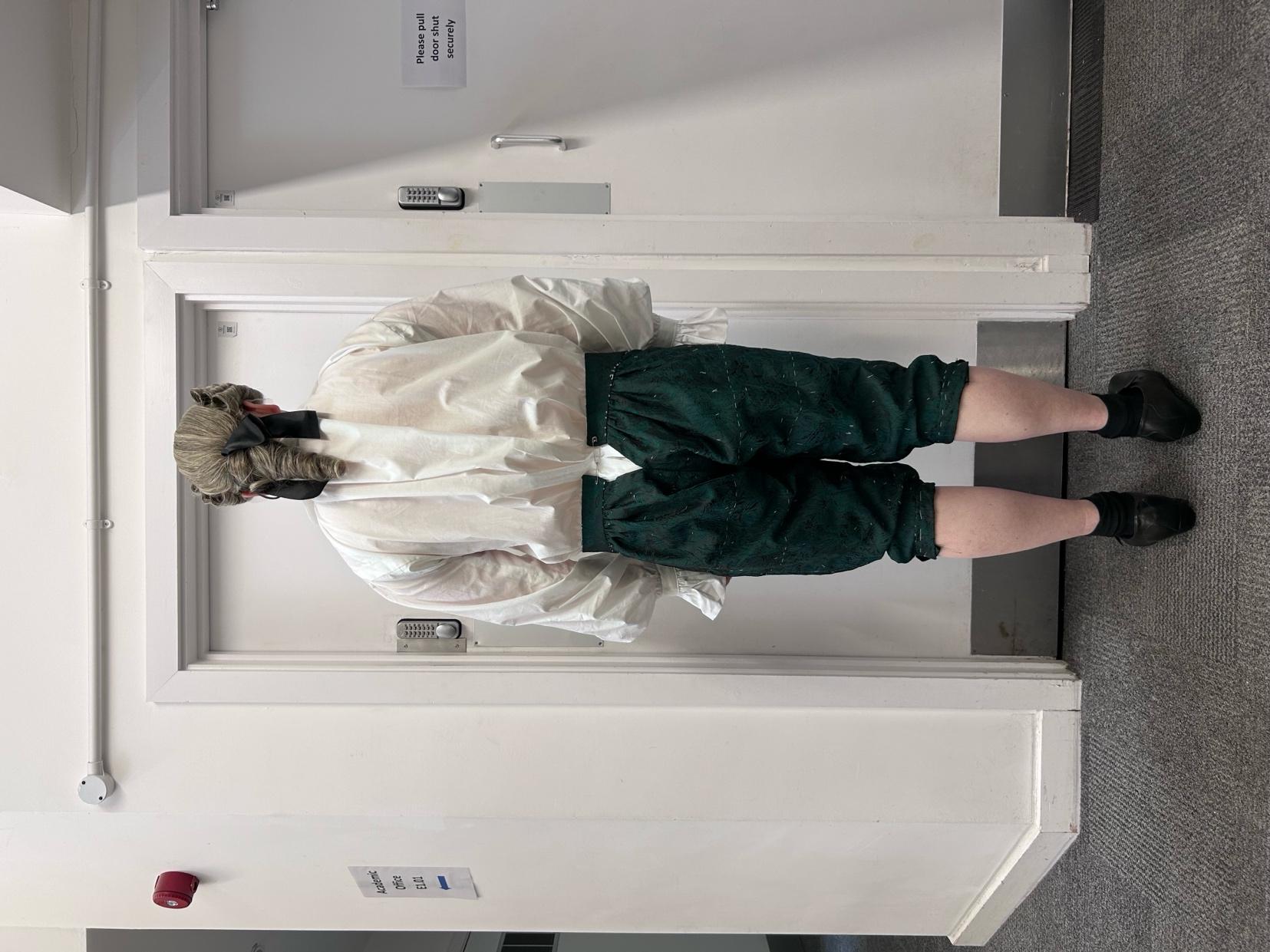


Before


Photos taken by Sophie Canniffe


Before Photos were missed during the fitting, this is where they would have been.







Photos taken by Sophie Canniffe
Fitting Notes
Character: Count Ottavio
Actor: Jamie McLaughlin
Maker: Emiliya Kezhina
Garment Notes
Breeches
Shirt
Jacket
Extra notes
Notes taken by Nicole McCafferty
• Let out 3 inches on the knee.
• Take up sleeve using pleat.
• Level pleats.
• Take cuff down by half and add lace.
• Scoop armhole to release sleeve.
• Add dart under cuff.
• Puff binder and foiling for decoration.
• Adjust neckline as pinned – take corner off
• VV Rouleaux Ribbon?
• Gold embellishments from Cristofolo


Pre-Assessment




Photos taken by R owan Smith




Pre-Assessment Notes
Character: Count Ottavio
Actor: Jamie McLaughlin
Maker: Emiliya Kezhina
Garment Notes
Breeches
Waistcoat
Jacket
Extra notes
Notes taken by Rosie Maddox
• Mark buttonholes on breeches
• Fastenings changed to slight diagonal.
• Buttons and buttonholes
• No foiling on jacket
• Pocket flaps need gold trim.
• Hat will be held – wig prevents wearing.


Final Photos




Costume Breakdown

Item Hire, Buy, Make?
Shirt and Breeches Make N/A N/A

Waistcoat Make

Jacket Make N/A



Cravat Make
Hat Make





Make Breakdown
Production La Casa Nova (Period)
Designer Maya Mansfield
Supervisor Larissa Gray
Maker Emiliya Kezhina
Actor Jamie McLaughlin
Character Count Ottavio
Part of costume



Cotton wadding AUB Haberdashery




£7.40
Buttons Jones Buttons
£2.50
Black cotton Empee silks
£2.25
Lining AUB
£7.50


Linen tape
Green Pe beads
Gold buttons
Thread




Waistcoat backing
Waistcoat Lining
Hair Canvas AUB
Haberdashery
£6.50 1m
£1.75
Eyelets AUB
Haberdashery
£0.04

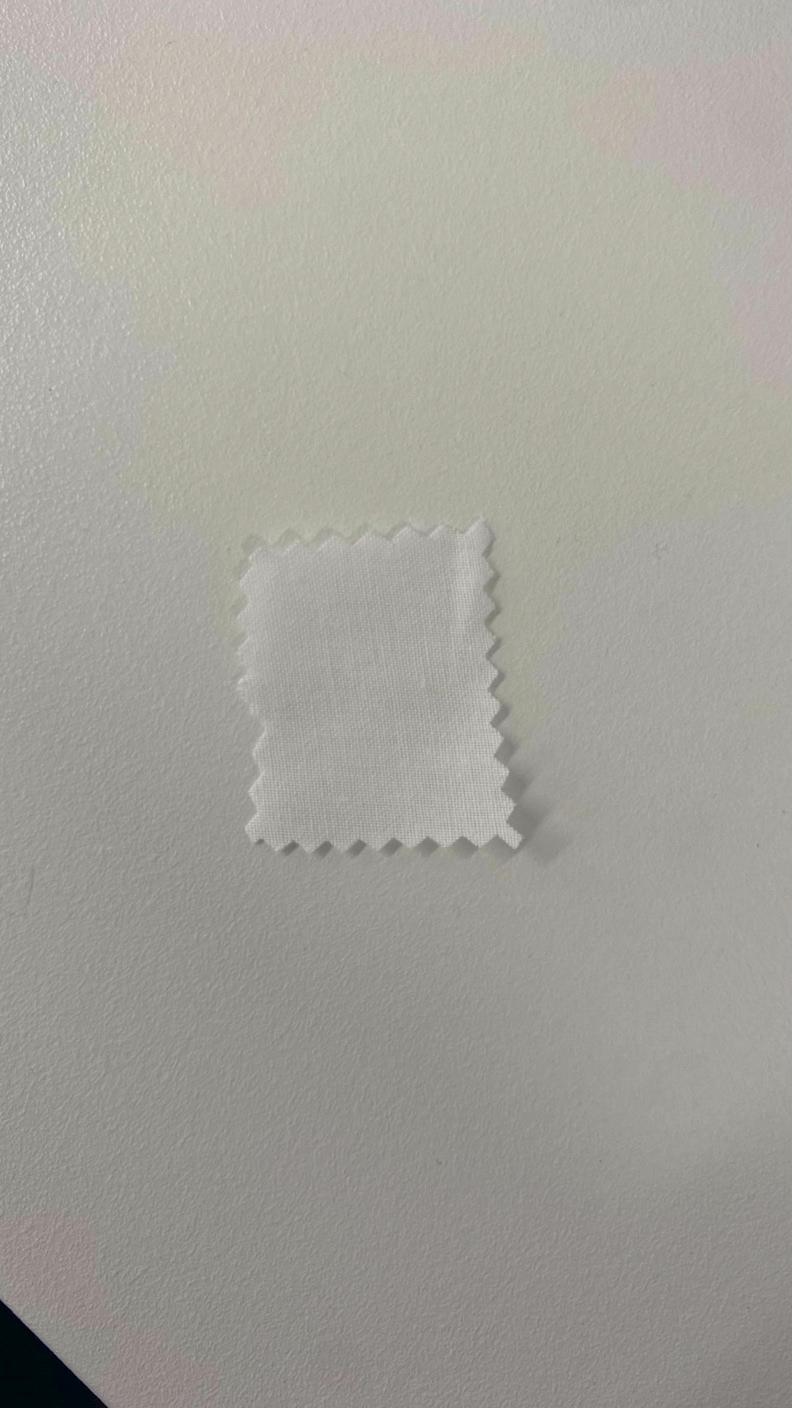
£1.25

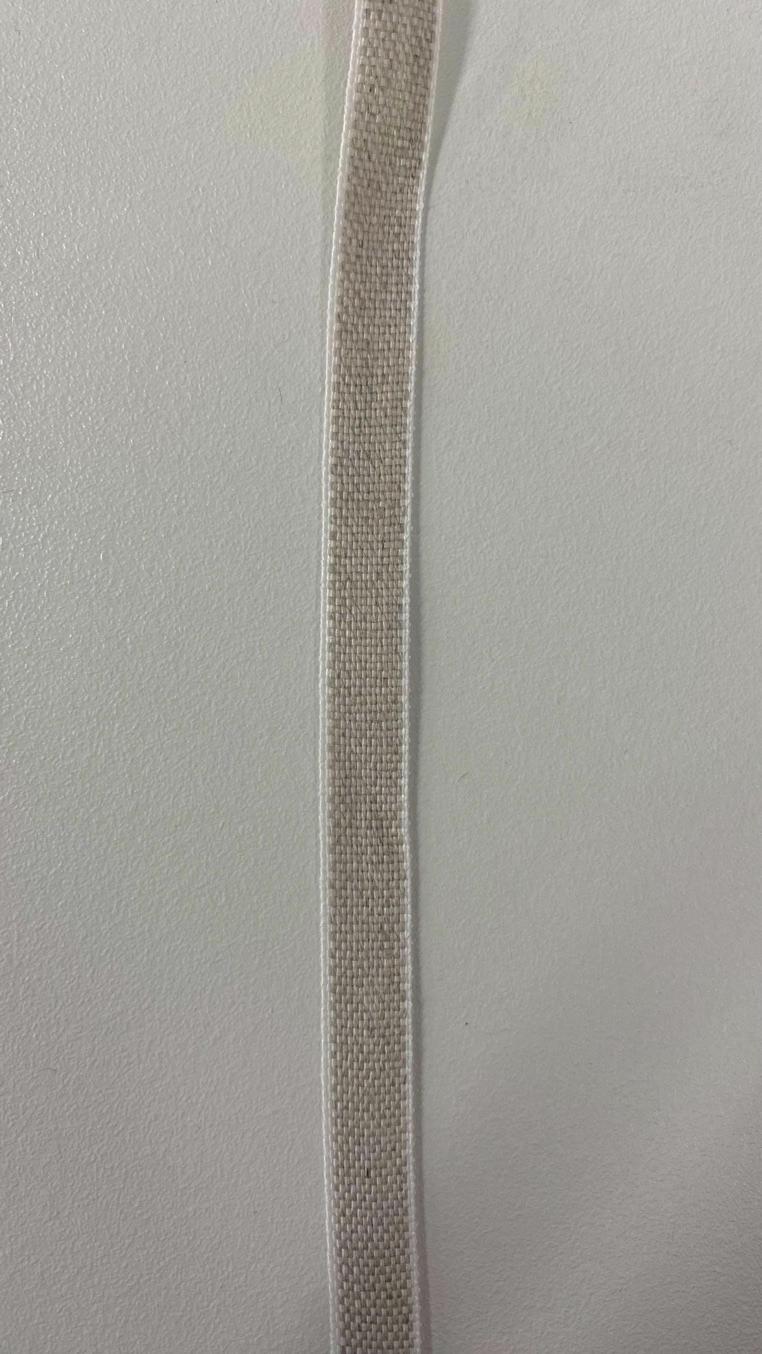
White cotton Empee Silks
Gold
Linen Tape VV Rouleaux




£22.50
Black cotton
Empee Silks
£2.25




Gold Buckles
Black corset lace
£ -




Shirt Cotton Lawn Empee Silks
£1.75 4m
Lace Etsy £0.80
White Thread Amazon
£1.29
Buttons AUB Haberdashery
Cravat Cotton Lawn Empee Silks
£1.75 See above
Scalloped Lace Etsy
£3.99 1m

Hat Black Petersham AUB Haberdashery
£0.60 3.33m

Felt stiffener AUB Haberdashery 100ml

Millinery wire AUB
Haberdashery
£0.85
Black lining AUB Haberdashery
£4.60 0.5m

velvet fabric AUB
£0.5m

AUB
£0.5m


Brown
Red velvet fabric
Gold button AUB
-
£16.00


Hat felt Petershams fabrics

Robert Elson







Photos taken by Jayne Jackson

Costume Design Fabrizio

Costume Design by Maya Mansfield


1st Fitting


Before


Photos taken by Rachel Lacey

After



Photos taken by Rachel Lacey
Fitting Notes
Character: Fabrizio
Actor: Robert Elson
Maker: Charlie Tolley
Garment Notes
Breeches
Shirt
Jacket
Waistcoat
Notes taken by Amelia Bavin
• At the back 3cm higher at the waist
• The elastic will be attached permanently to the breeches as braces.
• Let the collar out slightly.
• Make front leg of breeches bottom wider and let the knee band out a but #
• Tapered frill on the shirt, make it an oval not a circle.
• Open from neck to back pleat of the CB.
• Coat taken in a bit at the front so can see the waistcoat more.
• Widen the top of the cuff by an inch either side.
• The gold fabric in the cuff and the vent
• Pinning the new armhole on the waistcoat, making the armholes bigger
• Pocket is in the right place for the waistcoat.
• Drop waistcoat neckline lower.


2nd Fitting


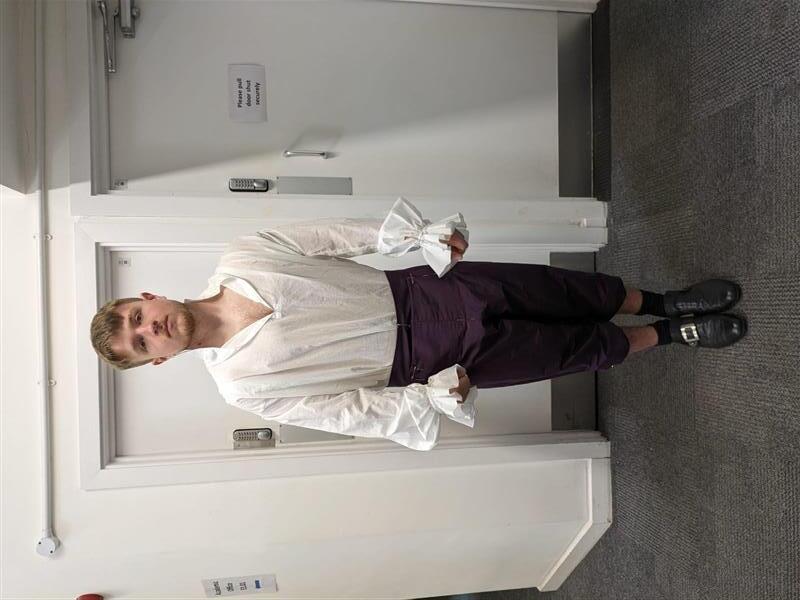
Before

Photos taken by Amelia Bavin


Before Photos of waistcoat and Jacket were missed during the fitting, this is where they would have been.




After


Photos taken by Amelia Bavin
Fitting Notes
Character: Fabrizio
Actor: Robert Elson
Maker: Charlie Tolley
Garment Notes
Breeches
Shirt
Jacket
Waistcoat
Extra Notes
Notes taken by Rachel Lacey
• Trim on breeches knee band and fastening
• Fastening on shirt: Loops
• Make sure the band of the shirt sleeve isn’t visible
• Let seam of jacket sleeve 1cm each side through to the cuff
• Top seam of jacket armhole needs drops down slightly.
• Gold trim around pocket of jacket as well as CF.
• Gold buttons from Jones for just the coat and go all the way down.
• Squared off cuff of jacket.
• There needs to be a little bit of space between the button/ hole and the braiding on jacket
• Front of waistcoat is open with bow.
• No trim needed for waistcoat.
• Silk or organza for the cravat
• Replace stud on Roberts left shoe.
• Dressing: Shirt needs to be put on properly and breeches in correct positioning, make sure neckline is correct and sleeves aren’t twisted


Pre-Assessment




Photos taken by R owan Smith




Photos taken by R owan Smith
Pre-Assessment Notes
Character: Fabrizio
Actor: Robert Elson
Maker: Charlie Tolley
Garment Notes
Waistcoat • Take in poppers on waistcoat.
Notes taken by Rosie Maddox


Final Photos




Costume Breakdown

Item Hire, Buy, Make?
Make N/A N/A
Make N/A N/A


Shirt
Breeches
Make N/A N/A
Make N/A N/A


Waistcoat
Jacket
Cravat Make N/A

Make N/A

Hat
Photo taken by Charlie Tolley



Tights Buy Move Dance £23.95
Cape


Make Breakdown
Production La Casa Nova (Period)
Designer Maya Mansfield
Supervisor Larissa Gray
Maker Charlie Tolley
Actor Robert Elson
Character Fabrizio
Part of costume Fabric/material
Jacket Purple Brocade Dazzle




Gold trim
Hair Canvas Haberdashery
£6.50
Chest canvas AUB
Haberdashery
£10.50 1m
Fabric AUB Haberdashery
£13.71
Stay flex AUB
Haberdashery
£4.70


white cotton Empee Silks
£1.75 4m


Linen
Gold thread AUB
£0
thread Minerva
£1.59
Trim Barnett and Lawson
£3.00
Wadding AUB Haberdashery
£3.70
reel
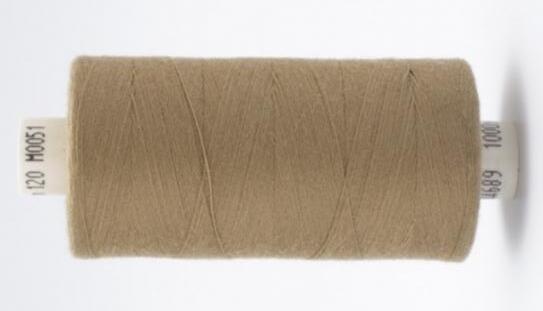

1 reel


Purple
£0.81

2.5m
Waistcoat lining AUB Haberdashery
£10.00

2.5m
Cream Waistcoat backing AUB Haberdashery
£5.00
1.5m


Waistcoat Gold Brocade Goldbrick Fabrics
£85.00
Purple
Stay flex AUB
Haberdashery
£4.70
Hair Canvas AUB
Haberdashery
£6.50

Linen Fabric AUB
Haberdashery
£13.71
Poppers 17mm AUB
Haberdashery
£2.00 4
0.5m



Cream Thread



Buttons
White corset lace
Breeches Eyelets Fabric wall
£0.04
£29.00




Purple Satin Classic
Domette
Buttons
Purple buttons
Haberdashery
£4.70
Haberdashery
£0.20

1m
£1.75
Lace for cuffs Etsy
4.5m
£0.80 1m
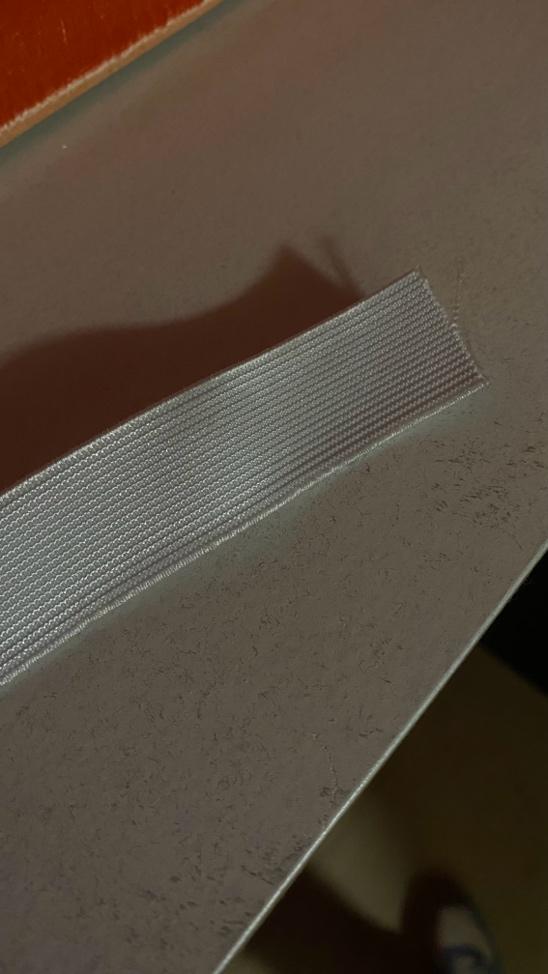


Shirt Cotton lawn Empee Silks
thread Amazon
£1.29
AUB Haberdashery
£ -

AUB
£ -



White
Buttons
Cravat Silk Habotai
Lace Etsy
£3.99
0.2m
Hat Black Petersham AUB
Haberdashery
£0.60 3.33m
Black lining AUB
Haberdashery
£4.60

Felt stiffener AUB
Haberdashery
£ -
Millinery wire AUB
Haberdashery
£0.84






Purple Feather Fabric wall
Grey Feather Fabric Land
£3.79 1
Purple Trim Barnett and Lawson
£3.06
3m
Hat felt Petershams fabrics
£16.00

Jake O’Mahoney






Photos taken by Jayne Jackson

Costume Design
Oswaldo
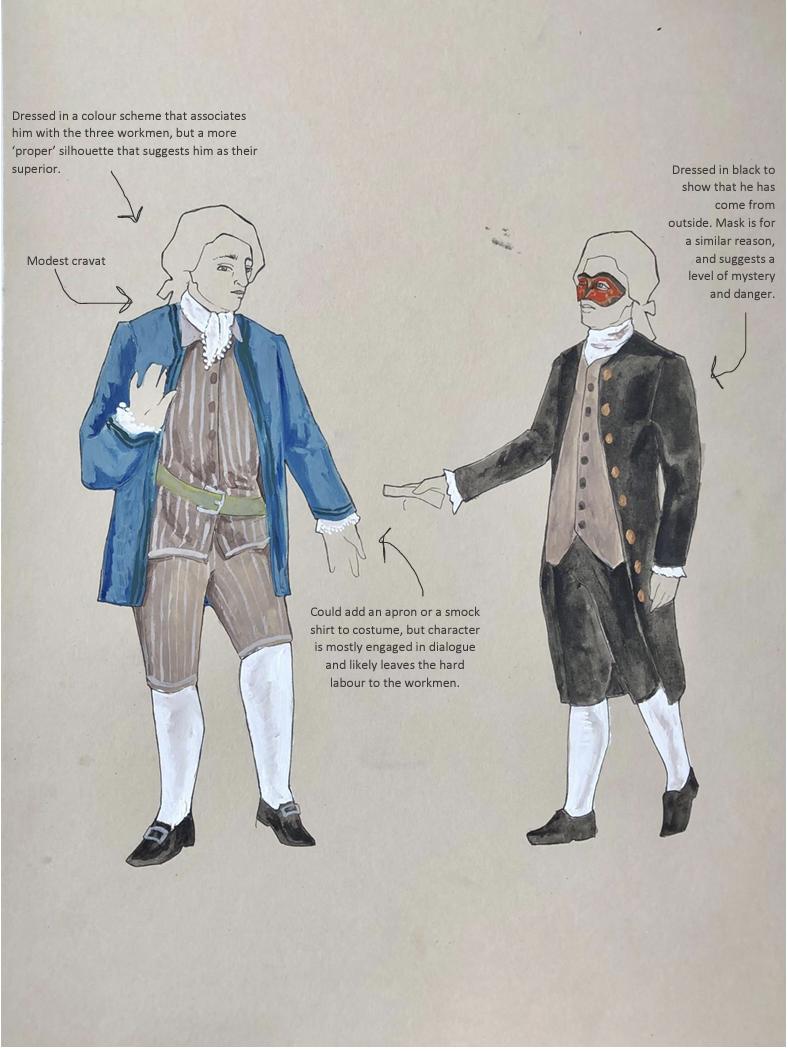


1st Fitting


Before Photos were missed during the fitting, this is where they would have been.


After




Photos taken by Rachel Lacey
Fitting Notes
Character: Ozwaldo
Actor: Jake O’Mahoney
Maker: Sophie Cheshire and Charlotte Adderson
Garment Notes
Breeches
Jacket
Waistcoat
Notes taken by Amelia Bavin
• Elastic on breeches
• Bottom of the knee band is where the bottom of the breeches has to go then add on the knee band, add on 1 inch or and 1 and a half.
• Take out the centre back and taper it into the crotch.
• Add on 1 inch to the bottom of the breeches width wise so they fit around his calves.
• Taking in the breeches at side along the pinning line, on the inside and the outside, taper the crotch, pookie crotch and bum.
• Need to readjust the lining on the cuffs and the wrists,
• Maybe change the buttons, look for the next fitting, look for wooden or leather or brown
• Measure buttons and count them.
• Re-pinned the waistcoat along the centre front.
• Didn’t need to snip into the armhole.


2nd Fitting





Photos taken by Rosie Maddox





Photos taken by Rosie Maddox


After



Photos taken by Rosie Maddox





Photos taken by Rosie Maddox
Fitting Notes
Character: Ozwaldo
Actor: Jake O’Mahoney
Maker: Sophie Cheshire and Charlotte Adderson
Garment Notes
Breeches
Jacket
Extra notes
Notes taken by Nicole McCafferty
• Take in at knee as pinned.
• Change buttons on jacket.
• Stock to be made.
• Wore Avery’s shoes.
• Add holes on shoes as drawn.
• Wide leather belt
• Dye tights grey.
• 2 hats for pre-assessment


Pre-Assessment


Photos were missed during the preassessment; this is where they would have been.






Pre-Assessment Notes
Character: Ozwaldo
Actor: Jake O’Mahoney
Maker: Sophie Cheshire and Charlotte Adderson
Garment Notes
Breeches
Waistcoat
Jacket
Extra notes
Notes taken by Rosie Maddox
• Fit very well.
• Waistcoat – will be laced white lace and buttons
• Secure pocket buttons
• More holes in belt
• Dressing notes – shoes, thread through the buckle
• Hat will be taken off quickly so can fit with wig.
• Black hat – tricorn
• Will have dance tights instead, staying white.
• Missing cravat, matte fabric


Final Photos




Costume Breakdown

Hire, Buy, Make?


Make N/A


Waistcoat
Cravat Hire AUB

Buy Move Dance £23.95


Tights
belt Hire AUB Costume Store
Store


Leather
Black Tricorn Hire AUB Costume


Make Breakdown
Production La Casa Nova (Period)
Designer Maya Mansfield
Supervisor Larissa Gray
Maker Charlotte Adderson and Sophie Cheshire
Actor Jake O’Mahoney
Character Oswaldo
Part of costume Fabric/material Supplier and price p/m
Waistcoat Striped fabric Pure edit
£29.00
Waistcoat Lining/backing AUB Haberdashery
£10.00



Cream collar fabric Fabric wall
Covered Buttons The trimming shop
£2.15 Pack of 50
AUB Haberdashery
AUB




Hair Canvas
£6.50
silver eyelets
£0.04
White Thread Amazon
£1.29




Linen Tape
White corset lace AUB
Breeches Stripey fabric
Wall


Estimated Budget (Makes)





Estimated Budget (Sourced)


Final Budget (Makes)

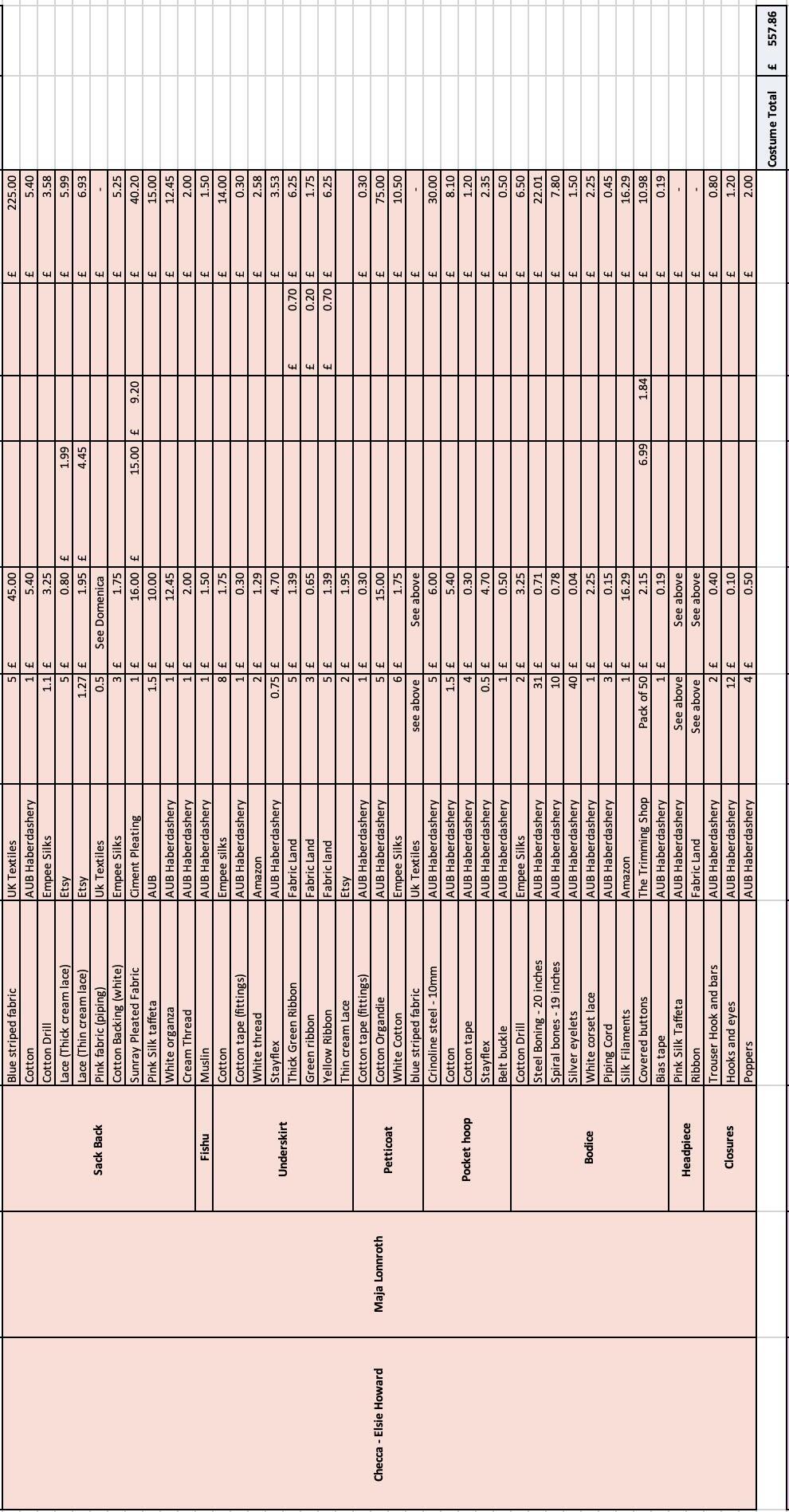










Final Budget (Sourced)


Hire forms.



Sustainability Assessment form



Supplier List
Dazzle
41a, 43 Goldhawk Rd, London W12 8QP
Goldbrick Fabrics
20 Goldhawk Rd, London W12 8DH
Classic Textiles
44 Goldhawk Rd, London W12 8DH
A to Z Fabrics
53A Goldhawk Rd, London W12 8QP
UK Textiles
45b, 47 Goldhawk Rd, London W12 8QP
AUB Haberdashery
Arts University Bournemouth, Dorset, BH12 5HH
Empee Silk Fabrics Ltd
31 Commercial Rd, London N18 1TP
Minerva
Minerva Crafts, Atlas Rd, Darwen BB3 3BY
Phone: 07591 117679
Opening Hours: N/A
Mon - Sat
Phone: 020 8743 2744
Opening hours: 10am – 6.30pm
Mon – Sat
Phone: 020 8743 3516
Opening hours: 9am – 6pm
Mon – Sat
Phone: 020 8222 6566
Opening Hours: 9.30am - 6.30pm
Phone: 020 8749 4077
Opening hours: 9.30am - 6pm
Phone: 01202 533011
Opening hours: 8am – 9pm
Mon - Fri
Phone: 020 8887 6000
Opening Hours: 9am – 5.30pm
Mon - Fri
Phone: 01254 708068
Opening Hours: 9am – 5pm
Pure Edit Fabrics
https://www.thepureedit.com/
Etsy
www.etsy.com
Spoilt Rotten Beans
7 The Green, Haddenham Fly, Cambridge shire, CB6 3TA
Petershams Millinery Supplies
Unit 21D, Barton Business Park, Canterbury CT1 3AA
VV Rouleaux
102 Marylebone Ln, London W1U 2QD
Ciment Pleating
18A Station Cl, Potters Bar EN6 1TL
Fabric Land
3 Dominion Road, West Howe Industrial estate, BH11 8lH
Phone: 0330 055 2996
Opening Hours: 9am – 5pm
Phone: N/A
Opening Hours: N/A
Phone: 01353 749853
Opening Hours: 9.30am – 5pm
Phone: 01227 287483
Opening Hours: 9am – 5pm
Mon - Fri
Phone: 020 7224 5179
Opening Hours: 10am – 6pm
Mon - Sat
Phone: 01707 661 311
Opening Hours: 7:30am – 4pm
Mon – Fri
Phone:01202580066
Opening Hours: 10am – 6pm
Mon - Sat
Barnett and Lawson
8, The Workshops, Greenfield Rd, Pulloxhill, Bedford MK45 5BF
Phone: 01234 38559
Opening Hours: 9am – 4pm
Mon - Fri

Bibliography
Angelica Kauffmann (2024) Encyclopædia Britannica. Available at: https://www.britannica.com/biography/Angelica-Kauffmann (Accessed: 28 March 2024).
A brief history of men’s underwear · V&A (no date) Victoria and Albert Museum. Available at: https://www.vam.ac.uk/articles/a-brief-history-of-mens-underwear (Accessed: 13 May 2024).
A brief history of lace: The lace guild (no date) TheLaceGuild. Available at: https://www.laceguild.org/a-brief-history-oflace#:~:text=Through%20the%20eighteenth%20century%20lace,increasing%20use%20of %20mesh%20grounds. (Accessed: 09 April 2024).
Burr, T. (2017) Embroidery in Italy, Trish Burr Embroidery Blog. Available at: https://trishburr.com/2017/08/15/embroidery-initaly/#:~:text=There%20are%20so%20many%20techniques,embroidery%20can%20be%2 0found%20here. (Accessed: 09 April 2024).
Bynde, T. (2020) The history of the walking stick, Ability Superstore. Available at: https://www.abilitysuperstore.com/blogs/news/the-history-of-the-walking-stick (Accessed: 12 May 2024).
Bender, A. (no date) 18th century accessories, Accessories for 18th Century Clothing. Available at: https://www.marquise.de/en/1700/howto/18accessoires.shtml (Accessed: 12 May 2024).
B, G. (no date) A brief history of passementerie, Gina. Available at: https://www.ginabsilkworks.co.uk/blog/a-brief-history-of-passementerie (Accessed: 08 May 2024).
Esposito, B. (no date) Adventures in fly fringe, The Closet Historian. Available at: https://theclosethistorian.blogspot.com/2013/07/adventures-in-fly-fringe.html (Accessed: 08 May 2024).
Fans in 18th century Europe (no date) The Fan Circle. Available at: https://fancircleinternational.org/fans-in-18th-century-europe/ (Accessed: 12 May 2024).
Folkwear (no date) History of the Parasol, Folkwear. Available at: https://www.folkwear.com/en-gb/blogs/news/historyoftheparasol (Accessed: 12 May 2024).
." fashion, costume, and culture: Clothing, headwear, body decorations, and footwear through the ages. . encyclopedia.com. 15 Apr. 2024 . (2024) Encyclopedia.com. Available at: https://www.encyclopedia.com/fashion/encyclopedias-almanacs-transcripts-andmaps/eighteenth-centuryfootwear#:~:text=Some%20shoes%20were%20laced%2C%20but,including%20the%20esp ecially%20popular%20slipper. (Accessed: 13 May 2024).
1770-1779 (2021) Fashion History Timeline. Available at: https://fashionhistory.fitnyc.edu/1770-1779/ (Accessed: 24 May 2024).
Men’s fashion in the 18th Century - Google Arts & Culture (no date) Google. Available at: https://artsandculture.google.com/story/men-s-fashion-in-the-18th-century-kyoto-costumeinstitute/0AURxWiFuypYKw?hl=en (Accessed: 24 May 2024).
1770-1779 (2021a) Fashion History Timeline. Available at: https://fashionhistory.fitnyc.edu/1770-1779/ (Accessed: 24 May 2024).
Robe en chemise (2019) Fashion History Timeline. Available at: https://fashionhistory.fitnyc.edu/robe-enchemise/#:~:text=%E2%80%9CThe%20term%20chemise%20was%20first,the%20chemise%20 %C3%A0%20la%20reine. (Accessed: 24 May 2024).
Goldoni (1968) La Casa Nova, Adobe Document Cloud for SharePoint/OneDrive. Available at: https://documentcloud.adobe.com/spodintegration/index.html?locale=en-us (Accessed: 22 February 2024).
Goldoni, C (1968) Four Comedies: The Venetian Twins/The Artful Widow/Miradolina/The Superior Residence. Translated by F.Davis. Suffolk, Great Britain: Penguin Classics.
Gunn, L.I. (2018) 18th century provencal undergarments, Decor To Adore. Available at: https://decortoadore.net/2018/10/18th-century-provencal-undergarments.html (Accessed: 24 May 2024).
Harvey, C. (2024) Italian embroidery, ClaireHarveyEmbroide. Available at: https://www.claireharveyembroidery.com/post/italian-embroidery (Accessed: 03 April 2024).
Hendrick, D. (2018) Embroidery inspiration - 18th century embroidery styles, Romantic Recollections. Available at: https://romanticrecollections.com/blog/2018/04/24/18thcentury-embroidery/ (Accessed: 08 May 2024).
History of corsets (2024) Wikipedia. Available at: https://en.wikipedia.org/wiki/History_of_corsets#:~:text=The%20primary%20purpose%20of%2 018th,freedom%20of%20movement%20to%20work. (Accessed: 24 May 2024).
History of stays 1740-1780 (no date) Silhouettes Costumes. Available at: https://silhouettescostumes.com/the-eras-we-build/history-of-stays-1740-1780/ (Accessed: 24 May 2024).
1700’s (2014) Historical Menswear. Available at: https://www.historicalmenswear.com/1700s/#:~:text=%E2%80%9CAt%20the%20beginning%2 0of%20the,with%20frills%20and%20linen%20underdrawers. (Accessed: 24 May 2024).
Italian lace history. reference list of Italian laces. (2020) World4 Costume Culture History. Available at: https://world4.eu/italian-lace/#google_vignette (Accessed: 09 April 2024).
Issimo (2023) Why Italian embroidery is the best, Issimo. Available at: https://issimoissimo.com/bellissimo/why-italian-embroidery-is-thebest/#:~:text=Italian%20embroidery%20techniques%20are%20renowned,unmatched%2C %20creating%20breathtakingly%20intricate%20designs. (Accessed: 03 April 2024).
Jefferson, T. (no date) Of parasols and umbrellas, – Thomas Jefferson’s Poplar Forest
Available at: https://www.poplarforest.org/4422/#:~:text=While%20utilized%20as%20an%20ungendered,eighteenth%20centuries%20(S angster%201855). (Accessed: 12 May 2024).
Kocian, C. (no date) 18th century stockings research , National Parks Service. Available at: https://www.nps.gov/articles/000/18th-century-stockings-research-by-carolkocian.htm#:~:text=Best,Best%3A%20Densely%20knit%20stockings%20of%20wool%2C%20linen%2C%20or%2 0cotton,the%20time%20of%20this%20writing.%5D (Accessed: 13 May 2024).
Kinnison, R. (1970) Fly fringe, Fly Fringe. Available at: https://ladysrepositorymuseum.blogspot.com/2012/12/fly-fringe.html (Accessed: 08 May 2024).
Long stocking spporters: 18th century (no date) long stockings spporters : 18th century. Available at: https://histclo.com/style/foot/stock/sup/chron/ssc18.html (Accessed: 13 May 2024).
La Casa Nova - Carlo Goldoni (2012) YouTube. Available at: https://www.youtube.com/watch?v=GqB7MXbxFp4&t=313s (Accessed: 23 February 2024).
Lace Types A HISTORICAL GUIDE TO EUROPEAN LACES (no date) Lace types: Italian Bobbin Lace. Available at: https://www.lacetypes.com/italy.html (Accessed: 09 April 2024).
Lace: A sumptuous history (no date) Lace: A Sumptuous History | SFO Museum. Available at: https://www.sfomuseum.org/exhibitions/lace-sumptuoushistory#:~:text=Both%20men%20and%20women%20wore,entire%20gowns%2C%20and %20decorated%20furnishings. (Accessed: 09 April 2024).
says:, Loren et al. (no date) Late 18th century skirt supports: Bums, rumps, & culs, Dmod. Available at: http://demodecouture.com/late-18th-century-skirt-supports/ (Accessed: 24 May 2024).
Moschino, P. (2023) Passementerie: The intricate craft of decorative trimmings, Paolo Moschino. Available at: https://www.paolomoschino.com/passementerie-the-intricatecraft-of-decorativetrimmings/#:~:text=Start%20by%20selecting%20the%20type,with%20different%20styles %20and%20combinations. (Accessed: 08 May 2024).
Marsh, G. (2017) 18th century embroidery techniques. Lewes: Guild of Master Craftsman Publications.
Men’s underwear: shirt and drawers (no date) Fashion and decor: A cultural history. Available at: https://mediakron.bc.edu/fashiondecor/daywear/mansshirt#:~:text=%22The%20shirt%20was%20an%20item,could%20be%20worn%20every% 20day. (Accessed: 13 May 2024).
Majer, M. (2021) 1770-1779 Fashion timeline, Fashion History Timeline. Available at: https://fashionhistory.fitnyc.edu/1770-1779/ (Accessed: 22 February 2024).
Martynova, K. (2023) Everything you need to know about Venetian Rococo, DailyArt Magazine. Available at: https://www.dailyartmagazine
(No date) Men’s underwear: Shirt and drawers | fashion and decor. Available at: https://mediakron.bc.edu/fashiondecor/mans-shirt (Accessed: 24 May 2024).
8th century Pocket Hoops (no date) Vena Cava Design. Available at: https://www.venacavadesign.co.uk/product.php/761/132/18th_century_pocket_hoops#:~:text=D uring%20the%2018th%20Century%2C%20a,false%20rump%20or%20pocket%20hoops. (Accessed: 24 May 2024).
Panniers (2017) Fashion History Timeline. Available at: https://fashionhistory.fitnyc.edu/panniers/ (Accessed: 24 May 2024).
18th century stockings research by Carol Kocian (U.S. National Park Service) (no date) National Parks Service. Available at: https://www.nps.gov/articles/000/18th-centurystockings-research-by-carolkocian.htm#:~:text=Stockings%20cut%20and%20sewn%20from%20knit%20fabric%20yardage %20using%20an,stay%20up%20better%20than%20stockings. (Accessed: 24 May 2024).
Robertson, J. (2023) Punto Antico: Classic Italian embroidery, PieceWork. Available at: https://pieceworkmagazine.com/punto-antico-classic-italian-embroidery/ (Accessed: 03 April 2024).
Rococo (2024) Encyclopædia Britannica. Available at: https://www.britannica.com/art/Rococo (Accessed: 28 March 2024).
Rococo style: Furniture, painting and sculpture guide (2020) Mayfair Gallery. Available at: https://www.mayfairgallery.com/blog/rococo-style-furniture-painting-sculpture-guide/ (Accessed: 28 March 2024).
Rococo movement overview (no date) The Art Story. Available at: https://www.theartstory.org/movement/rococo/#:~:text=In%20painting%20Rococo%20wa s%20primarily,foundational%20to%20Rococo%20interior%20design. (Accessed: 28 March 2024).
Shoes (no date) Historic New England. Available at: https://www.historicnewengland.org/explore/collectionsaccess/gusn/3400/#:~:text=Walk%20Right%20In%2011%2F98,the%20straps%20along%2 0the%20top (Accessed: 13 May 2024).
The rococo style – an introduction · V&A (no date) Victoria and Albert Museum. Available at: https://www.vam.ac.uk/articles/the-rococo-style-anintroduction#slideshow=74976771&slide=0 (Accessed: 28 March 2024).
The Italian Tribune (2021) Italian lace and its history, The Italian Tribune. Available at: https://italiantribune.com/italyandlace/#:~:text=It%20is%20divided%20into%20two,in%20Italy%20during%20the%20R enaissance. (Accessed: 09 April 2024).
The Dreamstress (2015) Inspirational embellishments, The Dreamstress. Available at: https://thedreamstress.com/2013/02/inspirational-embellishments/ (Accessed: 08 May 2024).
Women’s fashion in the 18th Century - Google Arts & Culture (no date) Google. Available at: https://artsandculture.google.com/story/women-s-fashion-in-the-18th-century-kyotocostume-institute/yQVxozIBUz__KQ?hl=en (Accessed: 24 May 2024).

List of Figures
Fig 1 Page 45
Image of Rococo influenced interior design.
https://dwello.in/news/the-ornate-tale-of-rococo-style-of-interior-design-from-europe-to-india
Accessed: 26.03.24
Fig 2 Page 46
Image of Rococo influenced furniture.
https://en.m.wikipedia.org/wiki/File:Juste-Aur%C3%A8le_Meissonnier__Canap%C3%A9_execut%C3%A9_pour_Mr._le_Comte_de_Bielinski_Grand_M.al_de_la_Couro nne_de_Pologne,_en_1735.;_Canap%C3%A9..._-_Google_Art_Project.jpg
Accessed: 26.03.24
Fig 3 Page 46
Image of a Rococo styled painting https://spenceralley.blogspot.com/2016/08/rococo-painting-in-italy.html
Accessed: 26.03.24
Fig 4 Page 46
Image of A Rococo influenced sculpture.
https://en.wikipedia.org/wiki/Rococo
Accessed: 26.03.24
Fig 5 Page 47
Image of an example of Italian Reticella embroidery
https://www.midorisnyder.com/handwork_and_the_craft/reticella/ Accessed: 03.04.24
Fig 6 Page 447
Image of an example of Punto Antico Italian embroidery
https://www.casacenina.com/les-edition-de-saxe/le-punto-antico.html Accessed: 03.04.24
Fig 7 Page 48
Image of a pocket from a man’s coat from the 1770’s. Marsh, G. (2017) 18th century embroidery techniques.
Accessed: 08.04.24
Fig 8 Page 48
Illustration of what the full jacket would look like in the 1770’s.
Marsh, G. (2017) 18th century embroidery techniques.
Accessed: 08.04.24
Fig 9 Page 49
Illustration of what silk embroidery would look like on clothing.
Marsh, G. (2017) 18th century embroidery techniques.
Accessed: 08.04.24
Fig 10 Page 49
Illustration of a diamond design of quilting that was put onto a petticoat hem.
Marsh, G. (2017) 18th century embroidery techniques.
Accessed: 08.04.24
Fig 11 Page 50
An image of Burano Lace
https://trishburr.com/2017/08/15/embroidery-in-italy/
Accessed: 09.04.24
Fig 12 Page 50
An image of venetian Rose Point Lace
https://www.jennysargeant.com/en-GB/antique-lace/antique-late-17th-century-venetian-rose-pointneedlelace-border/prod_10460
Accessed: 09.04.24
Fig 13 Page 51
Rope effect antique gold button from Jones buttons
https://webstore.jones-buttons.com/b79-rope-effect-28l-antique-gold-shank-button.html
Accessed: 09.04.24
Fig 14 Page 51
Elaborate Gold shank button from Jones Buttons
https://webstore.jones-buttons.com/b140-elaborate-34l-gold-shank-button.html
Accessed: 09.04.24
Fig 15 Page 51
Old Gold shank button from Jones buttons
https://webstore.jones-buttons.com/b900-ornate-40l-old-gold-22-shank-button.html
Accessed: 09.04.24
Fig 16 Page 51
Ornate Old Gold button from Jones Buttons
https://webstore.jones-buttons.com/b278-ornate-old-gold-shank-button.html
Accessed: 09.04.24
Fig 17 Page 51
Gold shank button from Etsy
https://www.etsy.com/uk/listing/1281916383/pack-of-6-22mm-gold-colouredshank?ga_order=most_relevant&ga_search_type=all&ga_view_type=gallery&ga_search_query=go ld+buttons&ref=sr_gallery-1-
24&frs=1&local_signal_search=1&content_source=30123665edf1d477b9f4a5afbe50576ed9806a2 5%253A1281916383&organic_search_click=1
Accessed: 09.04.24
Fig 18 Page 51
Ornate Gold metal shank button from Totally Buttons
https://www.totallybuttons.com/15mm-ornate-gold-metal-shankbutton.html?gad_source=1&gclid=Cj0KCQjwztOwBhD7ARIsAPDKnkDsKcaftauqKP_Tl9VLD6v v4KBA0YAbrfoIepPFJIwZfK6sXWGMEL8aAhL-EALw_wcB
Accessed: 09.04.24
Fig 19 Page 51
Gold textured buttons from oh sew crafty.
https://ohsewcrafty.co.uk/metal-buttons/33953-254576-1-x-round-shank-textured-solid-metal-coatbuttons-jacket.html?srsltid=AfmBOorUS2QS3qI6EjVG1NwPkML_Pk6qw1a258kP8tbgUgRRGMYG8xuV00#/42-colour-gold/2595-size-20mm
Accessed: 09.04.24
Fig 20 Page 52
Swirls and flower silver shank button from Jones Buttons
https://webstore.jones-buttons.com/b498-swirls-and-flower-silver-16-shank-button.html
Accessed: 09.04.24
Fig 21 Page 52
Plain silver shank button from Jones Buttons
https://webstore.jones-buttons.com/b433-plain-silver-9-shank-button.html
Accessed: 09.04.24
Fig 22 Page 52
Ornate old silver shank button from Jones Buttons
https://webstore.jones-buttons.com/b853-ornate-full-dome-40l-old-silver-shank-button.html
Accessed: 09.04.24
Fig 23 Page 52
Celtic knot silver button from Jones Buttons
https://webstore.jones-buttons.com/b75-celtic-knot-36l-old-silver-shank-button.html
Accessed: 09.04.24
Fig 23 Page 52
Dots antique silver button from Jones Button
https://webstore.jones-buttons.com/b472-dots-antique-silver-16-shank-button.html
Accessed: 09.04.24
Fig 25 Page 52
Fancy weave silver shank button from Jones Buttons
https://webstore.jones-buttons.com/b80-fancy-weave-28l-antique-silver-shank-button.html
Accessed: 09.04.24
Fig 26 Page 52
Celtic Knot silver button from Jones buttons
https://webstore.jones-buttons.com/b678-celtic-knot-28l-old-silver-shank-button.html
Accessed: 09.04.24
Fig 27 Page 53
Gold Trim from Barnett and Lawson
https://barnettlawson.co.uk/products/8148?_pos=8&_sid=17acc7645&_ss=r
Accessed: 10.04.24
Fig 28 Page 53
Gold Trim from Barnett and Lawson
https://barnettlawson.co.uk/products/7877?_pos=64&_sid=4ccaad76f&_ss=r&variant=4755087720 4777
Accessed: 10.04.24
Fig 29 Page 53
Gold Trim from Barnett and Lawson
https://barnettlawson.co.uk/products/6342?_pos=95&_sid=4ccaad76f&_ss=r&variant=4725916287 0057
Accessed: 10.04.24
Fig 30 Page 53
Gold Trim from Etsy
h https://www.etsy.com/uk/listing/1006835413/1-yard-indian-antique-goldhand?ga_order=most_relevant&ga_search_type=all&ga_view_type=gallery&ga_search_query=gold+trim&ref =sr_gallery-1-
1&sts=1&local_signal_search=1&content_source=ea933e0f01f9015ff6b12141d4782aede5dd13d1%253A1006 835413&organic_search_click=1
Accessed: 10.04.24
Fig 31 Page 53
Gold Trim from Barnett and Lawson
https://barnettlawson.co.uk/collections/all-braids-m/products/9101
Accessed: 10.04.24
Fig 32 Page 54
An example of fly fringe used on 18th century clothing.
https://theclosethistorian.blogspot.com/2013/07/adventures-in-fly-fringe.html
Accessed: 8.5.24
Fig 33 Page 5
An image of fly fringe pieces
https://theclosethistorian.blogspot.com/2013/07/adventures-in-fly-fringe.html
Accessed: 8.5.24
Fig 34 Page 54
An example of passementerie.
https://en.wikipedia.org/wiki/Passementerie
Accessed: 8.5.24
Fig 35 Page 55
A painting of a woman holding a parasol https://lifetakeslemons.wordpress.com/category/fashion/18th-c-accessories/
Accessed: 12.5.24
Fig 36 Page 55
An image of an 18th century fan
https://fancircleinternational.org/fans-in-18th-century-europe/ Accessed: 12.5.24
Fig 37 Page 55
An example of an 18th century walking stick https://www.bukowskis.com/en/lots/972341-an-18th-century-walking-stick
Accessed: 12.5.24
Fig 38 Page 57
An example of a pannier https://en.wikipedia.org/wiki/Pannier_%28clothing%29
Accessed on: 12/5/24
Fig 39 Page 57
An example of pocket hoops https://daniellefiore.blogspot.com/2017/02/18th-century-pocket-hoops.html
Accessed on: 12.5.24
Fig 40 Page 57
An example of an 18th century stays https://historicalcorsets.tumblr.com/post/132607418608/stays-spain-1770-75-yellow-silk-damask-donated
Accessed on: 12.5.24
Fig 41 Page 57
An example of a bum roll https://www.pinterest.co.uk/ideas/
Accessed on: 14.5.24
Fig 42 Page 58
An example of women’s Robe A La Francaise https://fashionhistory.fitnyc.edu/1770-1779/ Accessed: 14.5.24
Fig 43 Page 58
An example of the back of a women’s Robe A la Francaise https://fashionhistory.fitnyc.edu/1770-1779/
Accessed on: 20.5.24
Fig 44 Page 58
An example of an 18th century stomacher
https://artsandculture.google.com/story/women-s-fashion-in-the-18th-century-kyoto-costume-institute/yQVxozIBUz__KQ?hl=en Accessed on: 20.5.24
Fig 45 Page 59
An 18th century men’s shirt and drawers
https://collections.vam.ac.uk/item/O137722/drawers-underpants-unknown/ Accessed on: 21.05.24
Fig 46 Page 59
An example of 18th century men’s stockings https://www.liveauctioneers.com
Accessed on: 21.5.24
Fig 47 Page 60
An example of an 18th century Jabot https://www.metmuseum.org/art/collection/search/156780
Accessed 22.5.24
Fig 48 Page 61
An example of fall front breeches
https://drunktailor.livejournal.com/tag/early%2019th%20century%20trousers Accessed on: 20.05.24
Fig 49 Page 61
An example of an 18th century waistcoat
https://www.metmuseum.org/art/collection/search/157708
Accessed on: 21.05.24
Fig 50 Page 61
An example of an 18th century stock https://www.pinterest.co.uk/pin/18th-century-mans-stock 231794712043517680/ Accessed on: 21.5.24
Fig 51 Page 61
An example of a Habit a la Francaise
https://artsandculture.google.com/asset/man-s-suit-habit-%C3%A0-la-fran%C3%A7aise/iwHvUSRnpSgw-A
Accessed: 21.5.24
Fig 52 Page 62
Men’s 18th century shoes
https://www.darcyclothing.com/collections/mens-shoes/products/mens-c18th-buckle-shoes-spm18
Accessed on: 21.5.24
Fig 53 Page 62
Women’s 18th century shoes
https://www.darcyclothing.com/collections/womens-shoes/products/eighteenth-century-ladies-tongue-and-tie-shoes-sp1800
Accessed on: 21.5.24
Fig 54
An example of how to do an 18th century buckle
https://www.americanduchess.com/pages/how-to-fit-18th-c-shoe-buckles
Accessed on: 21.5.24

Appendix
CPD Hours
Maisie Perkins: Day of Dance fittings – 2 Hours
Nicole McCafferty: Peter Pan Fittings – 5 Hours
Maisie Perkins: Day of Dance alterations – 3 Hours
Maisie Perkins: Day of Dance dress run – 4 Hours.
Maisie Perkins: Day of Dance performance – 5 Hours
Nicole McCafferty: Peter Pan 2nd fittings – 3 Hours
Molly Pattinson: Panto Dame Dressing – 1 Hour
